This is a list of French battlefleet warships of the period 1640–1861:
Sections naming the Head of State are provided as chronological references.
Note that throughout this article the term "-pounder" refers to French pre-metric units of weight, which were almost 8% greater than UK/US units of the same name; every other maritime power likewise established its own system of weights and each country's 'pound' was different from that of every other nation. Similarly French pre-metric units of length (pieds and pouces) were 6.575% longer than equivalent UK/US units of measurement; the pre-metric French foot was equivalent to 324.8394 mm, whereas the UK/US foot equaled 304.8 mm. These differences should be taken into account in any calculations based on the units given below.
Francis I (1515 to 1547)
- Caraquon (1544)
- Grande Française (1533)
Louis XIII (1610 to 1643)
The first seven years of this reign were under the Regency of Marie de Médicis, the consort of Henri IV – Louis XIII's father, who had been assassinated in 1610. Following the Siege of Saint-Martin-de-Ré and the Siege of La Rochelle, and in line with his general efforts to enhance the prestige and status of France in Europe, the Cardinal de Richelieu had a number of warships purchased from Holland, and eventually built in France by Holland-instructed French engineers. The largest of these early ships of the line, such as the famous 72-gun Couronne launched in 1638, would mount a number of guns comparable to later units of the 18th and 19th century, but the brunt of these ships would mount between 20 and 40 guns. The artillery was also comparatively lighter: the Couronne mounted 18-pounder long guns on her main battery, where any of the numerous 74-gun ships of the line that formed the backbone of the Navy from the late 18th century would mount 36-pounder long guns and 18-pounders would become common on frigates.
Ships of the Line ("vaisseaux")
- Saint Louis (1621–1622)
- Saint Louis (1621–1625)
- Fortune (1625)
- Vierge 48 (purchased) – Captured by the Rochellais, blew up at Ile de Ré in 1625
- Espérance de Dieu (1627)
- Grand Saint Louis (1627)
- Neptune (1628)
- Saint Charles (1628)
- Cygne (1629)
- Madeleine de Brest (1629)
- Marguerite du Ponant (1629)
- Navire-du-Roi 52 (extant 1636)
- Saint Louis de Saint Jean de Luz (1636)
- Couronne 72 (launched ~1638)
- Faucon (1638)
- Triomphe (1638)
- Victoire (1638)
- Almirante (1638)
- Triton (1638)
- Levrette (1638)
- Vierge (1638)
- Tigre (1641)
- Dantzig (1641)
- Soleil (1642)
- Saint Thomas d'Aquin (1642)
- Gloire (1642)
- Grand Anglais (1643)
Louis XIV (1643 to 1715)
The first eight years of this reign were under the Regency of Anne of Austria, the consort of Louis XIII, while French politics were dominated by Cardinal Jules Mazarin, who served as Chief Minister from 1642, and Louis XIV did not achieve personal rule until the death of Cardinal Mazarin in March 1661.
The French rating system was initially created in 1669, but a more complete structure was introduced in 1671; earlier vessels are shown under the rating they were given in 1671 – in the case of vessels deleted prior to 1671, these are included according to the rate they would have been given in 1671 had they not been deleted. Under this system, French major warships were from 1671 divided into five ranks or "Rangs" (the initial system of 1669 had only four ranks); ships of the line (vaisseaux) were divided into the highest three ranks.
The original rating system was thoroughly reformed under Colbert's administration two years later, on 24 June 1671, and the overwhelming majority of French warships underwent name changes at that date; vessels are listed below under their original name at time of launching or acquisition, even if they subsequently were better known by the name they were given later.
Vessels of the Fourth and Fifth Ranks were categorised as frigates (frégates) of the 1st Order and 2nd Order respectively; light frigates (frégates légères) and even smaller vessels were excluded from the rating system. All these will be found listed under the article on French sail frigates.
First Rank Ships ("vaisseaux de Premier Rang")
From 1670, the First Rank was defined as ships of the line carrying more than 70 carriage guns; in 1690 this was redefined as ships carrying more than 80 guns. All First Rates from 1689 were three-decked vessels, i.e. carrying three complete gundecks, usually plus a few smaller carriage guns mounted on the gaillards (i.e. the quarter deck, forecastle and poop deck). Some ships built before 1689 were three-decked while others - while nominally three-deckers, had only a partially-armed third deck (in lieu of a forecastle and quarter deck) with no guns in the waist.
- Vendôme 66–72 guns (designed by Laurent Hubac, launched Spring 1651 at Brest) – classed as 1st Rate in 1669; renamed Victorieux in June 1671 but hulked in the following month and taken to pieces in 1679.
- Saint Philippe 78 (launched 3 February 1663 at Toulon) – classed as 1st Rate in 1669; burnt by the English in the Battle of La Hogue in June 1692
- Royal Louis 120, later 104 (launched 1 February 1668 at Toulon) – renamed Royal Louis Vieux 1692 and broken up 1697
- Dauphin Royal 100 (launched 29 March 1668 at Toulon) – broken up 1697
- Monarque 84 (launched 28 April 1668 at Toulon) – broken up 1700
- Royal Duc 104 (launched December 1668 at Brest) – renamed Reine in June 1671 and broken up 1688
- Ile de France 74/80 (launched 16 February 1669 at Toulon) – renamed Lis in June 1671 and broken up 1691
- Couronne 80/82 (launched 18 February 1669 at Brest) – broken up in 1712
- Paris 72/80 (launched March 1669 at Toulon) – renamed Royale Thérèse in June 1671 and broken up in 1692
- Henri 80 (launched 1669 at Tonnay-Charente) – renamed Souverain 1671, then renamed Admirable in June 1678
- Soleil Royal 120 (launched 13 December 1669 at Brest) – burnt by the English in an action at Cherbourg in June 1692
- Sceptre 80 (launched 11 February 1670 at Toulon) – broken up 1692
- Magnanime 76/80 (launched August 1673 at Marseille) – driven ashore and burnt in the Battle of Marbella in March 1705
- Victorieux 108 (launched in late 1675 at Rochefort) – broken up 1685 (badly built)
- Admirable 80/84 (launched 1678 at Brest) – renamed Souverain in June 1678 and broken up 1706
- Grand 84/88 (launched October 1680 at Rochefort) – broken up 1716 or 1717
- Magnifique 84 (launched 12 April 1680 at Toulon) – burnt by the English in the Battle of La Hogue in June 1692
- Conquérant 84 (launched 10 August 1688 at Toulon) – rebuilt 1707
- Intrépide 84 (launched March 1690 at Rochefort) – broken up 1724
- Saint Esprit 90/94 (launched 24 May 1690 at Brest) – renamed Monarque in June 1690, and broken up 1717
- Victorieux 88/94 (launched January 1691 at Rochefort) – broken up 1719
- Foudroyant 84/90 (launched 1691 at Brest) – burnt by the English in the Battle of la Hogue in June 1692
- Orgueilleux 90/94 (launched 29 March 1691 at Lorient) – broken up 1716–17
- Admirable 94 (launched 10 September 1691 at Lorient) – burnt by the English in an action at Cherbourg in June 1692
- Sceptre 84/88 (launched 10 November 1691 at Toulon) – broken up 1718
- Merveilleux 92/96 (launched 19 November 1691 at Brest) – burnt by the English in the Battle of La Hogue in June 1692
- Fulminant 98/96 (launched December 1691 at Rochefort) – broken up 1719
- Ambitieux 96 (launched December 1691 at Rochefort) – burnt by the English in the Battle of La Hogue in June 1692
- Formidable 96/94 (launched 4 December 1691 at Brest) – broken up 1714
- Lis or Lys 84/88 (launched 17 December 1691 at Toulon – driven ashore and burnt in the Battle of Marbella in March 1705
- Vainqueur 84 (launched 24 February 1692 at Lorient) – broken up 1722
- Royal Louis 112/110 (launched 22 September 1692 at Toulon) – broken up 1727
- Merveilleux 100/98 (launched 22 November 1692 at Brest) – broken up 1712
- Foudroyant 104 (launched 24 November 1692 at Brest) – exchanged names with Soleil Royal in March 1693 (see below), broken up 1714
- Magnifique 86/88 (launched 23 November 1692 at Rochefort) – broken up 1716 or 1717
- Ambitieux 92/96 (launched 5 December 1692 at Rochefort) – broken up 1713
- Admirable 96/90 (launched 23 December 1692 at Lorient) – broken up 1716 or 1717
- Terrible 100/104 (launched 21 February 1693 at Brest) – broken up 1714
- Tonnant 90 (launched September 1693 at Toulon) – sold to be broken up 1710
- Saint Philippe 90/92 (launched October 1693 at Toulon) – broken up 1714
- Triomphant 94/98 (launched 1 October 1693 at Lorient) – broken up 1725 or 1726
- Soleil Royal 104 (launched 14 November 1693 at Brest) – exchanged names with Foudroyant in March 1693 (before her launch), and broken up 1714
- Fier 90/94 (launched 1694 at Rochefort) – broken up 1713
Second Rank Ships ("vaisseaux de Deuxième Rang")
From 1670, the Second Rank was defined as ships of the line carrying from 56 up to 70 carriage guns; in 1683 this was redefined as ships carrying from 64 to 74 guns, and by 1710 even 64-gun ships had been reduced to the Third Rate. Most Second Rank ships were two-decked vessels, i.e. carrying two complete gundecks, usually plus a few smaller carriage guns mounted on the gaillards; however, the Second Rank initially also included thirteen smaller three-deckers launched up until 1682, after which all three-deckers were First Rates; these three-deckers are listed below before the two-deckers.
Three decked ships:
- Rubis 60/64 (launched November 1664 at Brest) – captured by English in September 1666, becoming French Ruby in the English Navy; broken up 1685.
- Fort 68/70 (launched 11 April 1669 at Rochefort) – renamed Foudroyant in June 1671, broken up 1690
- Madame 72/76 (launched 28 February 1670 at Touloin) – renamed Pompeux in June 1671; hulked 1696, sold 1709
- Royale Thérèse 70/76 (launched 4 March 1670 at Toulon) – renamed Saint Esprit in June 1671; condemned 1689 and sold 1692
- Joli 70/80 (launched 2 October 1670 at Toulon) – renamed Henri in June 1671; deleted 1686, sold 1687
- Rubis 72/76 (launched 15 October 1670 at Toulon) – renamed Florissant in June 1671; hulked 1696, broken up after 1700
- Vermandois 70/76 (launched June 1671 at Rochefort) – renamed Superbe in June 1671, broken up 1687
- Orgueilleux 70/76 (launched early 1672 at Rochefort) – broken up 1688
- Brave 74/76 (launched 20 June 1675 at Brest) – renamed Constant in June 1675, then Triomphant in June 1678; burnt by the English in an action at Cherbourg in June 1692
- Courtisan 72/76 (launched 1676 at Brest) – renamed Belliqueux in June 1678; broken up 1708
- Terrible 76 (launched 1680 at Brest) – burnt by the English in the Battle of La Hogue in June 1692
- Tonnant 76 (launched August 1681 at Brest) – burnt by the English in the Battle of La Hogue in June 1692
- Fier 76 (launched 1682 at Brest) – burnt by the English in the Battle of La Hogue in June 1692
Two decked ships:
- Reine 60 guns (designed by Gédéon Rodolphe, launched February 1647 at Toulon) – classed as 2nd Rate in 1669, then reduced to 50 guns in 1670 and reclassed as 3rd Rate in 1671; renamed Brave in June 1671 but hulked in 1673 and taken to pieces in 1674.
- Saint Louis 60 guns (designed by Jean Laure, launched July 1658 at Soubise) – classed as 2nd Rate in 1669, then reduced to 56 guns in 1670 and reclassed as 3rd Rate in 1671; renamed Aimable in June 1671; removed from service in 1688 and taken to pieces in 1690.
- Bourbon 66 (launched 22 November 1665 at Soubise) – renamed Eclatant (64 guns) in June 1671; deleted 1684
- Prince 64/66 (launched April 1666 at Brest) – renamed Sans Pareil in June 1671; wrecked 1679
- Frederic 70/80 (launched early 1666 at Copenhagen – built by contract) – renamed Admirable in June 1671, broken up 1677
- Conquérant 66/72 (launched November 1666 at Amsterdam – built by contract) – wrecked 1679
- Courtisan 64/72 (launched December 1666 at Amsterdam – built by contract) – renamed Magnifique in June 1671; hulked 1684 and broken up around 1693
- Intrépide 66/76 (launched December 1666 at Amsterdam – built by contract) – renamed Grand in June 1671; broken up 1678
- Invincible 64/74 (launched December 1666 at Amsterdam – built by contract) – deleted about 1680
- Neptune 64/74 (launched December 1666 at Amsterdam – built by contract) – renamed Illustre in June 1671; broken up 1698
- Normand 66/72 (launched December 1666 at Amsterdam – built by contract) – renamed Saint Louis in June 1671; broken up 1680
- Princesse 64 (launched early March 1667 at Soubise) – renamed Triomphant in June 1671, then Constant in June 1678; hulked as Vieux Constant 1690, deleted by 1704
- Charente 60/66 (launched February 1669 at Rochefort) – renamed Belliqueux in June 1671, then Courtisan in June 1678 (although latter change never took effect); wrecked 1678
- Français 62/66 (launched 25 October 1669 at Brest) – renamed Glorieux in June 1671; burnt in action 1677
- Terrible 68/70 (launched 19 September 1670 at Brest) – wrecked 1678
- Tonnant 64/66 (launched 19 September 1670 at Brest) – wrecked 1678
- Parfait 60/64 (launched 20 July 1671) – reclassed as 3rd Rate, condemned 1699
- Saint Michel 60/64 (launched August 1673 at Marseille) – broken up 1687
- Glorieux 62/66 (launched early 1679 at Brest) – broken up 1719
- Ardent 64/66 (launched 1680 at Le Havre) – Captured by the Dutch in the Battle of Marbella in March 1705
- Bourbon 64 (launched 1683 at Rochefortt) – burnt by the English in the Battle of La Hogue in June 1692
- Courtisan 64/66 (launched October 1686 at Rochefort) – Burnt by accident 1702
- Content 64/66 (launched 23 December 1686 at Toulon) – captured by the English 1695
- Serieux 64; later 58 (launched 11 January 1687 at Toulon) – renamed Croissant 1688, then reverted to Serieux 1689; broken up 1718
- Eclatant 68/70 (launched 28 June 1688 at Toulon) – lost 1713
- Henri 68 (launched 13 August 1688 at Dunkirk) – burnt 1736
- Brillant 64/66 (launched January 1690 at Le Havre) – reclassed as 3rd Rang 1707; condemned 1719–22
- Aimable 64/68 (launched March 1690 at Rochefort) – burnt by accident 1715
- Superbe 70 (launched 1690 at Toulon) – captured and wrecked in the Battle of Vigo Bay in October 1702
- Invincible 70 (launched 1690 at Toulon) – condemned 1727 and broken up 1748
- Heureux 68/70 (launched November 1690 at Toulon) – captured by the English 1710
- Constant 68/70 (launched 28 November 1690 at Toulon) – deleted 1714
- Gaillard 66 (launched December 1690 at Le Havre) – burnt by the English in the Battle of La Hogue in June 1692
- Laurier 60 (launched December 1690 at Bayonne) – burnt 1705
- Sirène 60 (launched 1691 at Bayonne) – captured and wrecked in the Battle of Vigo Bay in October 1702
- Saint Esprit 74/76 (launched early 1691 at Rochefort) – broken up after 1718
- Ecueil 66/68 (launched March 1691 at Dunkirk) – deleted 1709
- Juste 62/66 (launched 20 December 1691 at Le Havre) – broken up 1719
- Bizarre 68 (launched Autumn 1692 at Bayonne) – broken up 1727
- Bourbon 68 (launched 1692 at Toulon) – captured by the Dutch in the Battle of Vigo Bay in October 1702
- Saint Louis 64/66; later 58/60 (launched 10 December 1692 at Le Havre) – sold 1712
- Prompt 70/76 (launched 1692 at Dunkirk) – captured by the English in the Battle of Vigo Bay in October 1702
- Fort 70 (launched 1693 at Rochefort) – burnt in the Battle of Vigo Bay in October 1702
- Éole 62/64 (launched 23 February 1693 at Le Havre) – sold 1710
- Content 60/64, later 54 (launched September 1695 at Toulon) – sold 1712
- Ferme 66/70 (launched 1700 at Rochefort) – captured by the English in the Battle of Vigo Bay in October 1702
- Parfait 72/76 (launched 14 March 1701 at Toulon) – sold 1726
- Toulouse 62 (launched 8 December 1703 at Toulon) – reclassed as 3rd Rate 1707, captured by the British 1711
- Oriflamme 60/62 (launched 15 January 1704 at Toulon) – reclassed as 3rd Rate 1709, broken up 1727
- Neptune 72 (launched 27 August 1704 at Toulon) – wrecked 1713
- Achille 62–64 (launched 23 February 1705 at Brest) – reclassed as 3rd Rate 1707, broken up 1744
- Saint Michel 70/74 (launched 1 February 1706 at Lorient) – broken up 1719
- Lis or Lys 72 (launched June 1706 at Brest) – broken up 1747
- Magnanime 72 (launched 6 October 1706 at Brest) – wrecked 1712
- Pompeux 72 (launched August 1707 at Rochefort) – broken up 1719
- Conquérant 70 (launched February 1712 at Toulon) – broken up 1743
Third Rank Ships ("vaisseaux de Troisième Rang")
From 1670, the Third Rank was defined as ships of the line carrying from 40 up to 50 carriage guns; in 1671 this was redefined as ships carrying from 48 to 60 guns. During the first decade of the 18th century, the remaining Second Rank ships with 64 or fewer guns were down-graded (without change of armament) to Third Rank. All Third Rank ships were two-decked vessels, i.e. carrying two complete gundecks, usually plus a few smaller carriage guns mounted on the gaillards.
- Royale 56/58 (launched 1661 at Brest) – renamed Ferme 1671, condemned 1676
- Chalain or Grand Chalain 42/48 (seized 1661, built 1660 at Concarneau) – renamed Triomphe 1662, then Courageux in June 1671; condemned 1672 and broken up
- Dauphin 52/54 (launched 1664 at Toulon) – renamed Vermandois 1671, then Vigilant 1678; condemned 1699 and broken up 1700
- Diamant 60 (launched 1664 at Brest) – broken up 1685
- Thérèse 58 (launched 1665 at Toulon) – blew up in action 1669
- Brave 50/54 (launched March 1670 at Rochefort) – renamed Prince in June 1671; wrecked in May 1678
- Louvre 50 (launched 29 April 1670 at Brest) – renamed Bourbon in June 1671; wrecked in May 1678
- Oriflamme 50 (launched 1 November 1670 at Brest – wrecked February 1691
- Navarrais 56 (launched 22 November 1670 at Rochefort) – renamed Excellent in June 1671; deleted 1676 or 1677
- Arrogant 58 (launched 1682 at Le Havre) – captured by the English in the Battle of Marbella in March 1705
- Marquis 56/60 (launched 1685 at Toulon) – captured by the Dutch in the Battle of Marbella in March 1705
- Modéré 52/56 (launched 1685 at Dunkirk) – captured by the English in the Battle of Vigo Bay in October 1702
- Maure 50/54 (launched 1688 at Toulon) – captured by the British in 1710, renamed Moor
- Fortuné 54/58 (launched July 1689 at Toulon) – Burnt August 1707
- Fleuron 56/58 (launched July 1689 at Toulon) – Scuttled July 1707
- Perle 50/52 (launched December 1690 at Dunkirk) – Lost 1709
- Entendu 58/60 (launched 1691 at Dunkirk) – deleted 1701
- Capable 58/60 (launched 1692 at Dunkirk) – broken up 1706
- Indien 56 (launched 22 October 1692 at Lorient) – lost 1699
- Bon 56 (launched 17 August 1693 at Brest) – deleted 1703
- Gaillard 50–56 (launched 1693 at Bayonne) – captured by the British in 1710
- Fougueux 50–56 (launched 1695 at Brest) – captured by the English in 1696, sank 1696
- Téméraire 50–56 (launched 1695 at Brest) – broken up 1723
- Trident 56/60 (launched 1695 at Toulon) – broken up 1720
- Solide 50 (launched 1695 at Brest) – burnt in the Battle of Vigo Bay in October 1702
- Mercure 52–60 (launched 1696 at Brest) – captured by the English in 1746
- Assuré 60 (launched 1697 at Toulon) – captured by the English in the Battle of Vigo Bay in October 1702 and added to the RN as HMS Assurance 70, BU 1712
- Prudent 60 (launched 1697 at Toulon) – burnt in the Battle of Vigo Bay in October 1702
- Hasardeux 50 (launched 1699 at Lorient) – captured by the English in 1703 and added to the RN as HMS Hazardous
- Oriflamme 64 (launched 1699 at Toulon) – burnt in the Battle of Vigo Bay in October 1702
- Amphitrite 50/52; later 46/48 (launched October 1700 at Dunkirk) – renamed Protée in March 1705; deleted 1722
- Triton 50–52 (launched 1703 at Bayonne) – deleted 1720
- Jason 54–58 (launched 2 May 1704 at Brest) – deleted 1720
- Auguste 54–58 (launched 3 May 1704 at Brest) – captured by the English in August 1705 and added to the RN as HMS August.
- Hercule 56–60 (launched 22 June 1705 at Lorient) – broken up 1746
- Mars 54 (launched December 1705 at Lorient) – broken up 1720
- Dauphine 60 (launched 23 March 1706 at Le Havre) – broken up 1719
- Bourbon 54 (launched 26 June 1706 at Lorient) – captured by Dutch privateers in March 1707 and renamed Gekronde Burg.
- Superbe 56 (launched 12 December 1708 at Lorient) – Captured by the British in 1710 and added to the RN as HMS Superb 64, BU 1732
Fourth Rank Ships ("vaisseaux de Quatrième Rang")
From 1670, the French Quatrième Rang consisted of vessels with two complete batteries ("two-deckers") armed with from 30 to 40 guns. From 1671, this was redefined as vessels armed with from 36 to 46 guns, and those vessels with fewer than 36 guns were re-classed as Fifth Rank ships; in 1683 this was revised again to include only two-decked ships with from 40 to 46 guns. These ships were also described as frigates (frégates) of the 1st Order, and appear also in the appropriate article.
- Infante 36 (launched June 1661 at Brest) – renamed Ecueil in June 1671; wrecked 1673
- Jules 38 (launched July 1661 at Toulon) – renamed Indien in June 1671; wrecked 1673
Beaufort Class (2 ships)
- Beaufort 36–38 (launched 15 May 1662 at Toulon) – renamed Neptune in June 1671, then Maure in January 1679; condemned 1686
- Mercoeur 36 (launched July 1662 at Toulon) – renamed Trident in June 1671; condemned 1686
- Duc 42–46 (launched 1665 at Brest) – renamed Comte in June 1671; wrecked 1676
- Sirène 44–46 (launched June 1666 at Toulon) – wrecked 1684
- Cheval Marin 44–46 (launched June 1666 at Toulon) – broken up 1729
- Ecueil 40–44 (launched 2 November 1678 at Le Havre) – sold 1689
- Leger 40 (launched 3 November 1679 at Le Havre) – scondemned 1695
- Solide 44 (launched 6 November 1683 at Dunkirk) – wrecked 1694
- Emporte 44 (launched 20 November 1683 at Dunkirk) – condemned 1705 and abandoned
- Gaillard 44–48 (launched 17 November 1684 at Le Havre) – sold 1689
- François 48–52 (launched 20 October 1687 at Le Havre) – broken up 1736
- Trident 50 (launched 22 June 1688 at Toulon) – captured by the English in 1695, added to the RN under the same name
- Alcyon 40 (launched July 1689 at Dunkirk) – broken up 1718
- Adroit 44 (launched 20 January 1691 at Le Havre) – sunk 1703
Poli Class (2 ships)
- Opiniatre 40 (launched July 1691 at Rochefort) – deleted 1699
- Poli 40 (later 36) (launched August 1691 at Rochefort) – broken up 1717
- Pélican 44 (launched 1693 at Bayonne) – sunk in 1697 in Hudson Bay
- Mutine 40 (launched 28 May 1695 at Brest) – deleted 1708
- Volontaire 44 (launched late August 1695 at Toulon) – reduced to 36 guns in 1701; captured and wrecked in the Battle of Vigo Bay in October 1702
- Amphitrite 42/44 (launched 1696 at Rochefort) – burnt by accident 1713
- Avenant 42 (launched September 1696 at Brest) – burnt by accident 1704
- Dauphine 40/42 (launched 9 January 1697 at Le Havre) – burnt in the Battle of Vigo Bay in October 1702
- Triton 44 (launched January 1697 at Brest) – captured by the English in the Battle of Vigo Bay in October 1702
- Thetis 44 (launched 1697 at Rochefort) – captured by the English 1705
- Renommée 44–48 (launched early 1698 at Bayonne) – deleted 1723
- Maurepas 46 (begun as Hazardeux but renamed June 1698; launched October 1698 at Lorient) – given to the Compagnie des Indes 1698, recovered 1703 but transferred again 1705
- Adélaïde 44 (launched 10 January 1699 at Toulon) – wrecked 1714
- Dryade 44–46 (launched 21 October 1702 at Le Havre) – captured by the British 1709
Parfaite Class (2 ships)
- Parfaite 40 (launched 29 September 1704 at Toulon) – sunk 1718
- Vestale 40 (launched 1705 at Toulon) – broken up 1739
- Griffon 44–50 (launched 10 January 1705 at Lorient) – captured by the British in 1712, but returned; broken up 1748
- Thetis 44–50 (launched 20 June 1705 at Brest) – captured by the British in 1707
Atalante Class (2 ships)
- Atalante 40–44 (launched February 1707 at Le Havre) – condemned 1729–33
- Diane 42–44 (launched February 1707 at Le Havre) – deleted 1711
- Amazone 40–42 (launched 16 April 1707 at Brest) – hulked 1741, broken up 1748
- Gloire 38 (launched 18 April 1707 at Lorient) – captured by the British in 1709, became HMS Sweepstakes; broken up 1716
- Argonaute 42–50 (launched 14 November 1708 at Brest) – hulked 1720, broken up 1746
Captured or otherwise acquired from foreign navies
- ? (ex-Spanish galleon, captured 1639)
- ? (ex-Spanish galleon, captured 1640)
- ? (ex-Spanish vice-admirals galleon, captured 1643 (Battle of Cape Gata))
- ? (ex-Spanish galleon, captured 1643 (Battle of Cape Gata))
- ? (ex-Algerine, captured 1665, ex-Dutch Giardino d'Olanda (Hollandsche Tuyn) 40)
- Saint Cosme 50/52, 3rd Rang (ex-Spanish San Cosimo, captured 1672) – Broken up 1677
- Saint Pierre 50/52, 3rd Rang (ex-Spanish San Pedro, captured 1674) – Sold 1681
- Defenseur 54, 3rd Rang (ex-Dutch Beschermer, captured 1677) – Wrecked 1678
- ? 50 (ex-English, captured 1691)
- ? 50 (ex-English, captured 1691)
- ? 40 (ex-English, captured 1691)
- ? 40 (ex-Dutch, captured 1691)
- ? 54 (ex-Dutch, captured by Maure & Modéré 1692)
- ? 48 (ex-Dutch, captured by Maure & Modéré 1692)
- ? 62 (ex-Spanish galleon, captured 1692)
- ? 64 (ex-Dutch, captured 1693)
- ? 64 (ex-Dutch, captured 1693)
- ? 50 (ex-English, captured 1694) (same as next?)
- Espérance d'Angleterre 70, 2nd Rang (ex-English Hope, captured 1695) – Recaptured and wrecked in the Battle of Vigo Bay in October 1702
- ? 44 (ex-Dutch, captured 1696) – Scuttled by fire to prevent recapture
- ? (ex-Spanish galleon, captured by des Augiers 1696)
- ? (ex-Spanish galleon, captured by des Augiers 1696)
- Rotterdam 40, 4th Rang (ex-Dutch Rotterdam, captured 1703) – Deleted 1706
- Elizabeth 70, 2nd Rang (ex-English Elizabeth, captured 1704) – Deleted 1720
- Coventry 50, 4th Rang (ex-English Coventry, captured 1704) – Recaptured 1709
- Falmouth 50, 4th Rang (ex-English Falmouth, captured 1704) – Wrecked 1706
- Pendennis 54, 3rd Rang (ex-English Pendennis, captured 1705) – Sold 1706
- Blekoualle 54, 3rd Rang (ex-English Blackwall, captured 1705) – Recaptured 1708
- Mercure 40–42, 4th Rang (ex-Dutch Mercurius, captured 1705) – Captured by the English 1707
- ? 50 (ex-Dutch Hardenbroek, captured 1706) – To Russia 1712 as Esperans 44
- Grafton 70, 2nd Rang (ex-English Grafton, captured 1707) – Broken up 1744
- Hampton Court 70, 2nd Rang (ex-English Hampton Court, captured 1707) – Sold 1713
- Cumberland 84, 2nd Rang (ex-British Cumberland, captured 1707) – To Genoa 1715, to Spain 1717, renamed Principe de Asturias, captured by Britain at the Battle of Cape Passaro, 1718, to Austria 1720, renamed San Carlos, BU 1733
- Grand Vainqueur 54 (c. 1706, ex-Dutch Overwinnaer, captured 1708) – To Britain, to Russia 1712 as Viktoria
- Gloucester 60/64 (ex-British Gloucester, captured 1709) – To Genoa 1711, to Spain 1720, renamed Conquistador 62/64, stricken 1738
- Pembroke 60, 3rd Rang (ex-British Pembroke, captured 1710) – Retaken but foundered 1711
- Le Beau Parterre (c. 1710, ex-Dutch Schonauwen, captured 1711) – Intended for Russia but captured on delivery voyage by Sweden 1713/14, renamed Kronskepp
Louis XV (1715 to 1774)
The first eight years of this reign were under the Regency of Philippe of Orléans, Duke of Chartres, the nephew of Louis XIV.
While the five Rangs theoretically remained in existence, the construction by 1715 had crystallised around a number of distinct types, based on the number of carriage guns which they carried.
First Rates ("vaisseaux de Premier Rang") of the Louis XV era
Few three-decker ships were built during this reign, only four being completed during the sixty years.
- Foudroyant 110 (launched April 1724 at Brest) – BU 1742
- Royal Louis 118 (never launched – burnt by arson on the stocks in 1742)
- Royal Louis 116 (launched May 1759 at Brest) – BU 1772
- Ville de Paris 90 (launched 19 January 1764 at Rochefort) – Laid down as Impétueux. Enlarged to 104 guns, captured by the British in the Battle of the Saintes in April 1782, sank in a storm in September 1782
- Bretagne 100 (launched 24 May 1766 at Brest) – Renamed Révolutionnaire, BU 1796
| First Rates of the Louis XV era |
|---|
| Model of the fictitious ship Sans-Pareil that defined the type of Royal Louis (1758) |
| Scale model of Bretagne, on display at Brest naval museum |
|
80-gun ships ("vaisseaux de 80") of the Louis XV era
Large two-deckers, these served usually as fleet flagships.
- Tonnant 80 (launched 17 November 1743 at Toulon, design by François Coulomb the Younger) – BU 1780
- Soleil Royal 80 (launched 30 June 1749 at Brest) – Driven ashore by the British and burnt at the Battle of Quiberon Bay in November 1759
- Foudroyant 80 (launched 18 December 1750 at Toulon) – Captured by the British near Cartagena in February 1758 and added to the RN under the same name, BU 1787
- Formidable 80 (launched June 1751 at Brest) – Captured by the British in the Battle of Quiberon Bay in November 1759 and added to the RN under the same name, BU 1768
- Duc de Bourgogne 80 (launched 20 October 1751 at Rochefort) – renamed Peuple in September 1792, then Caton in February 1794; BU 1800–1801
- Océan 80 (launched 20 June 1756 at Toulon) – Driven ashore and burnt by the British in the Battle of Lagos in August 1759
- Orient 80 (1756) – (launched 9 October 1756 at Lorient) – Built for the Compagnie des Indes, bought by the French Navy in May 1759, wrecked in the East Indies 1782
- Saint-Esprit 80 (launched 12 October 1765 at Brest) – renamed Scipion 1794; wrecked in a storm 1795
- Languedoc 80 (launched 14 May 1766 at Toulon) – Captured by the British at Toulon in August 1793, retaken by the French in December 1793. Renamed Anti-fédéraliste in April 1794, then renamed Victoire in May 1795, BU 1799
- Couronne 80 (launched May 1768 at Brest) – Accidentally burnt 1781
74-gun ships ("vaisseaux de 74") of the Louis XV era
These formed overwhelmingly the core of the French battlefleet throughout the 18th century. Initially these carried just 26 guns in their first (lower deck) battery and 28 guns in their second (upper deck) battery, with 16 guns on the gaillards - the total of 74 guns being achieved by having 4 small guns (4-pounders) on the 'dunette' (poop). From the Terrible (of 1739) onwards, the lengthened hulls of new ships meant that they could mount an extra pair of guns on the lower deck and another extra pair on the uppdeck deck; the 4 small guns on the dunette were henceforth abolished.
- Sceptre 74 (launched July 1720 at Brest)
- Bourbon 74 (launched September 1720 at Brest)
- Saint Philippe 74 (launched 1722 at Rochefort)
- Duc d'Orléans 74 (launched 13 August 1722 at Toulon)
- Phénix 74 (launched 17 March 1723 at Toulon)
- Espérance 74 (launched 8 August 1723 at Toulon)
- Ferme 74 (launched 11 November 1723 at Toulon)
- Neptune 74 (1723) – Captured by the British in the Second Battle of Cape Finisterre in October 1747
- Juste 74 (launched September 1725 at Rochefort)
- Saint Esprit 74 (launched 9 January 1726 at Toulon)
- Superbe 74 (launched 27 June 1738 at Brest)
- Dauphin-Royal 74 (launched 13 October 1738 at Brest)
- Terrible 74 (launched 19 December 1739 at Toulon) – captured by the British in the Second Battle of Cape Finisterre in October 1747 and added to the RN under the same name, BU in 1763
- Invincible 74 (launched 21 October 1744 at Rochefort) – captured by the British in the First Battle of Cape Finisterre in May 1747 and added to the RN under the same name, wrecked in February 1758
- Magnanime 74 (launched 22 November 1744 at Rochefort) – captured by the British in January 1748 and added to the RN under the same name, BU 1775
- Conquérant 74 (launched 10 March 1746 at Brest, design by François Coulomb the Younger) – Out of service −3-1764 for rebuilding (new ship launched 1765)
- Monarque 74 (launched March 1747 at Brest) – captured by the British in the Second Battle of Cape Finisterre in October 1747
- Intrépide 74 (launched 24 March 1747 at Brest)
- Sceptre 74 (launched 21 June 1747 at Brest)
- Magnifique 74 (launched 7 March 1749 at Brest)
- Téméraire 74 (launched 24 December 1749 at Toulon, design by François Coulomb the Younger) – captured by the British in the Battle of Lagos in August 1759 and added to the RN as HMS Temeraire, sold 1784
- Couronne 74 (launched 1749 at Rochefort)
- Florissant 74 (launched 11 August 1750 at Rochefort)
- Entreprenant 74 (launched 19 October 1751 at Brest) – burnt by the British in the siege of Louisbourg in July 1758
- Redoutable 74 (launched 5 May 1752 at Toulon, design by François Coulomb the Younger) – driven ashore and burnt by the British in the Battle of Lagos in August 1759
- Palmier 74 (launched c.21 July 1752 at Brest)
- Héros 74 (launched 1 September 1752 at Brest) – wrecked in combat with the British in the Battle of Quiberon Bay in November 1759
- Prudent 74 (launched 28 July 1753 at Rochefort) – burnt by the British in the siege of Louisbourg in July 1758
- Guerrier 74 (launched 7 September 1753 at Toulon) – Captured by the British at Toulon in August 1793, retaken there by the French in December 1793, captured and burnt by the British in the Battle of the Nile in August 1798.
- Courageux 74 (launched 11 October 1753 at Brest) – captured by the British in August 1761 and added to the RN under the same name, wrecked 1796
- Défenseur 74 (launched 6 March 1754 at Brest)
- Hector 74 (launched 23 July 1755 at Toulon) – captured by the British in the Battle of the Saintes in April 1782, recaptured by the French in September 1782
- Diadème 74 (launched 26 June 1756 at Brest) – renamed Brutus in September 1792, BU 1797
- Glorieux 74 (launched 10 August 1756 at Rochefort) – captured by the British in the Battle of the Saintes in April 1782, sank in a storm in September 1782
- Zodiaque 74 (launched 19 November 1756 at Brest)
- Centaure 74 (launched 17 March 1757 at Toulon) – captured by the British in the Battle of Lagos in August 1759 and added to the RN as HMS Centaur, wrecked off Newfoundland in 1782
- Minotaure 74 (launched April 1757 at Brest)
- Souverain 74 (launched 6 June 1757 at Toulon) – Captured by the British at Toulon in August 1793, retaken there by the French in December 1793, renamed Peuple-Souverain c. 1794, captured by the British in the Battle of the Nile in August 1798 and added to the RN as HMS Guerrier, BU 1810.
- Robuste 74 (launched 2 September 1758 at Lorient)
- Thésée 74 (launched 28 January 1759 at Brest)
- Protecteur 74 (launched 21 May 1760 at Toulon)
- Couronne Ottomane 74 (launched September 1760 at Istanbul for the Ottoman Navy, and purchased August 1761 for France) – returned to the Ottomans in January 1762
- Diligent 74 (launched November 1762 at Lorient-Caudan)
- Six Corps 74 (launched 29 December 1762 at Lorient-Caudan)
- Citoyen 74 (launched 27 August 1764 at Brest)
- Conquérant 74 (launched 29 November 1765 at Brest) – Captured by the British at Toulon in August 1793, retaken there by the French in December 1793, captured by the British in the Battle of the Nile in August 1798 and added to the RN under the same name
- Bourgogne 74 (launched 26 June 1766 at Toulon)
- Marseillais 74 (launched 16 July 1766 at Toulon) – renamed Vengeur du Peuple in February 1794, sunk by the British in the Glorious First of June 1794
- Palmier 74 (launched December 1766 at Brest) – Captured by the British in April 1782
- Actif 74 (launched 5 October 1767 at Brest)
- Bien-Aimé 74 (launched 22 March 1769 at Lorient)
- Victoire 74 (launched 4 October 1770 at Lorient)
finally, two 74-gun ships were begun in Louis XV's reign to the designs of the Bien-Aimé and César respectively, but were not launched until some years later.
- Fendant 74 (begun February 1772, launched 11 November 1776 at Rochefort) – wrecked 1784
- César class
- Zélé 74 (launched 1 July 1763 at Toulon)
- César 74 (launched 3 August 1768 at Toulon) – captured by the British and burnt at the Battle of the Saintes in April 1782
- Destin 74 (begun April 1770, launched 21 October 1777 at Toulon) – captured by the British at Toulon in August 1793 and burnt by them there in December 1793
64-gun ships ("vaisseaux de 64") of the Louis XV era
- Ardent 64 (launched 1723 at Rochefort) – driven ashore and wrecked by the British in Quiberon Bay in October 1746
- Fleuron 64 (launched 29 April 1730 at Brest) – burnt at Brest 1745
- Borée 64 (launched 22 December 1734 at Toulon, design by François Coulomb the Younger) – wrecked 1746
- Sérieux 64 (26 October 1740 at Toulon) – captured by the British in the First Battle of Cape Finisterre in May 1747
- Trident 64 (launched 13 September 1742 at Toulon) – captured by the British in the Second Battle of Cape Finisterre in October 1747
- Triton 64 (launched 4 August 1747 at Toulon, design by François Coulomb the Younger)
- Achille 64 (launched 15 November 1747 at Toulon) – captured by the British in July 1761
- Jason 64 (1748) – a ship of the Compagnie des Indies, not a naval ship; captured in 1748
- Saint Michel class
- Saint Michel 64 (launched January 1741 at Brest)
- Vigilant 64
- Mars class
- Mars 64 (launched May 1740 at Brest) – captured by the British off Ireland in October 1746 and added to the RN under the same name, wrecked at Halifax 1755
- Alcide 64 (launched 6 December 1743 at Brest) – captured by the British off North America in June 1755 and added to the RN under the same name, sold 1772
- Lys class
- Lys 64 (launched c.10 September 1746 at Brest) – captured by the British off North America in June 1755
- Fougueux 64 (launched March 1747 at Brest) – Captured by the British at the Second Battle of Cape Finisterre in October 1747
- Dragon 64
- Content class
- Content 64
- Orphée 64 (launched 10 May 1749 at Toulon) – captured by the British in February 1758
- Hardi class
- Hardi 64 (launched 1750 at Rochefort) – captured by the British at Toulon in August 1793, retaken there by the French in December 1793.
- Inflexible 64
- Protée class
- Illustre class
- Vaillant class
- Vaillant' 64 (launched 1 October 1755 at Toulon)
- Modeste 64 (launched 12 February 1759 at Toulon) – captured by the British in the Battle of Lagos in August 1759 and added to the RN under the same name, BU 1800
- Altier class
- Altier 64 (launched 23 May 1760 at Toulon)
- Lion 64 (launched 22 May 1751 at Toulon)
- Fantasque 64 (launched 10 May 1758 at Toulon)
- Sage 64 (launched 29 December 1751 at Toulon)
- Bizarre 64 (launched September 1751 at Brest)
- Capricieux 64 (launched 13 September 1753 at Rochefort) – burnt by the British in the siege of Louisbourg in July 1758
- Bienfaisant 64 (launched 13 October 1754 at Brest) – captured by the British in the siege of Louisbourg in July 1758 and added to the RN under the same name, BU 1814
- Duc d'Aquitaine 64 a French East India Company ship, not a naval vessel – captured by the British in May 1757 and added to the RN under the same name, wrecked 1761
- Raisonnable 64 (launched November 1756 at Rochefort) – captured by the British in May 1758 and added to the RN under the same name, sank off Martinique 1762
- Célèbre 64 (launched February 1757 at Brest) – burnt by the British in the siege of Louisbourg in July 1758
- Sphinx class, design by Salinoc
- Sphinx 64 (launched in 1756, rebuilt by engineer Ollivier and relaunched 9 December 1776 at Brest) – hulked at Rochefort in May 1793 as a floating battery and disarmed in January 1802.
- Belliqueux 64 (launched August 1756 at Brest) – captured by the British near Ilfracombe in November 1758
- Sainte Anne class
- Sainte Anne 64 – captured by the British in 1761 and added to the RN as HMS St. Anne, sold 1784
- Hazard 64
- Rencontre 64
- Saint François de Paule 64
- Provence 64 (1763)
- Union 64 (launched late 1763 at Brest)
- Vengeur 64 (launched 25 October 1756 at Lorient for the Compagnie des Indies, and purchased July 1765)
- Artésien class of five ships to design by Joseph-Louis Ollivier
- Artésien 64 (launched 7 March 1765 at Brest)
- Roland 64 (launched 14 February 1771 at Brest)
- Alexandre 64 (launched 28 February 1771 at Brest) – captured 1782
- Protée 64 (launched 10 November 1772 at Brest) – captured by the British in February 1780 and added to the RN as HMS Prothee, BU 1815
- Éveillé 64 (launched 10 December 1772 at Brest)
Three French East India Company ships were purchased by the Navy in April 1770
- Actionnaire 64 (launched 22 December 1767 at Lorient for the Compagnie des Indes, purchased in April 1770 by the Navy) – captured by the British in the Bay of Biscay in April 1782
- Indien class
- Indien 64 (launched 30 July 1768 at Lorient for the Compagnie des Indes, purchased in April 1770 by the Navy)
- Mars 64 (launched 17 August 1769 at Lorient for the Compagnie des Indes, purchased in April 1770 by the Navy)
Two further ships were built at Brest in the early 1770s
- Brillant 64 (launched September 1774 at Brest)
- Solitaire 64 (launched 22 October 1774 at Brest)
Finally, two 64-gun ships were begun under Louis XV, but were not launched until some years later.
- Réfléchi 64 (launched 25 November 1776 at Rochefort) – renamed Turot in 1793
- Caton 64 (launched 5 July 1777 at Toulon)
Two-deckers of 60 guns ("vaisseaux de 60") of the Louis XV era
- Content 60 (launched March 1717 at Lorient)
Two-deckers of 50 guns ("vaisseaux de 50") of the Louis XV era
- Jason 50–58 (launched 1 April 1724 at Le Havre) – Captured by the British in the First Battle of Cape Finisterre in May 1747 and added to the RN under the same name, sold 1793
- Tigre 50–58 (launched 19 October 1724 at Toulon) – BU 1754 at Quebec
- Brillant 50–58 (launched October 1724 at Brest) – BU 1754 at Quebec
- Alcyon 50–58 (launched 14 March 1726 at Toulon) – Burnt 1757
- Rubis 50–58 (launched 18 November 1728 at Le Havre) – Captured by the British in the First Battle of Cape Finisterre in May 1747 and added to the RN under the same name
- Diamant 50–58 (launched 4 September 1733 at Toulon, design by François Coulomb the Younger) – Captured by the British in the First Battle of Cape Finisterre in May 1747 and added to the RN as HMS Isis
- Apollon 50–58 (launched 1740 at Rochefort) – Scuttled at Louisbourg in 1758
- Auguste 50–58 (launched January 1741 at Brest) – Captured by the British in 1746 and added to the RN as HMS Portland's Prize
- Caribou 50–58 (launched 13 May 1744 at Quebec) – Deleted 1757
- Oriflamme 50–56 (launched 30 October 1744 at Toulon) – Captured by the British 1761.
- Etoile 50–58 (launched April 1745 at Le Havre) – Burnt 1747 to avoid capture by the British
- Arc-en-Ciel 50–58 (launched 1745 at Bayonne) – Captured by the British near Louisbourg in 1756
- Fier 60–62 (launched 1 December 1745 at Toulon) – Deleted 1782
- Vigilant 64 (1745) – Captured by the British near Louisbourg in May 1745, added to the RN as HMS Vigilante, sold 1759
- Hippopotame 50–58 (launched 5 July 1749 at Toulon) – sold and renamed Fier Rodrigue in November 1777
- Amphion 50–58 (launched 28 July 1749 at Brest) – Deleted 1787
- Aigle 50–58 (launched 1750 at Rochefort) – Stranded 1758
- Sagittaire 50–58 (launched 8 August 1761 at Toulon) – Deleted 1787
Bordelois class: group of four ships designed by Antoine Groignard and built at Bordeaux by Léon-Michel Guignace
- Bordelois 50–58 (launched 26 April 1763 at Bordeaux) – Razeed to frigate 1768; converted into an indiaman 1776; deleted 1778; reactivated 1780 as États d'Artois; taken by Britain 1780 and renamed HMS Artois
- Ferme 50–58 (launched 10 October 1763 at Bordeaux) – Deleted 1774
- Utile 50–58 (launched 14 August 1764 at Bordeaux) – Deleted 1771
- Flamand 50–58 (launched 11 May 1765 at Bordeaux) – deleted 1785 or 1786
- Dauphin 50–56 (c. 1770?) – Ex-Indiaman. Sold 1773
Small two-deckers of 42 – 48 guns ("vaisseaux de 40 à 48") of the Louis XV era
- Argonaute 44–50 (launched July 1722 at Brest) – hulked 1741
- Parfaite 44–50 (launched January 1723 at Brest) – burned accidentally 1746
- Néreïde 44–50 (launched 26 March 1724 at Rochefort) – deleted 1743
- Gloire 44–50 (launched 5 November 1727 at Le Havre) – captured by the British in the First Battle of Cape Finisterre in May 1747 and added to the RN as HMS Glory
- Aquilon 44–50 (launched 24 November 1733 at Toulon) – Destroyed 1756
- Aurore 44–50 (launched 3 April 1745 at Rochefort) – Deleted 1753
- Junon 44–50 (launched c.September 1747 at Le Havre)
- Danae 44–50 (launched 13 September 1756 at Le Havre)
Captured or otherwise acquired from foreign navies in the Louis XV era
- Poder 60–62 (ex-Spanish Poder, sold by Spanish Navy for merchant service 1740 and captured February 1744) – burnt February 1744
- Severn 40–48 (ex-British Severn of 48 guns, captured 1746) – recaptured by the British in the Second Battle of Cape Finisterre in October 1747
- Warwick 60–62 (ex-British Warwick, captured March 1756) – recaptured by the British in January 1761
- Greenwich 50–58 (ex-British Greenwich, captured March 1757) – wrecked January 1758
- ? 70/80 (ex-Maltese San Salvadore, obtained 1760/61, ex-Turkish Corona Ottomana, mutinied and handed over 1760) – Returned to Turkey 1761
Louis XVI (1774 to 1792)
First Rates ("vaisseaux de Premier Rang") of the Louis XVI era
110-gun three-decker group of 1780. Three different constructeurs designed these ships; the first two were by François-Guillaume Clairain-Deslauriers and Léon-Michel Guignace respectively, while the Toulon pair were by Joseph-Marie-Blaise Coulomb. Typically each carried 30 x 36pdr guns on the lower deck, 32 x 24pdr guns on the middle deck, 32 x 12pdr guns on the upper deck, and 16 x 8pdr guns on the gaillards, although this armament varied from time to time.
- Invincible 110 (begun February 1779, launched 20 March 1780 and completed May 1780 at Rochefort) – condemned in 1806 and broken up in 1808.
- Royal-Louis 110 (begun March 1779, launched 20 March 1780 and completed June 1780 at Brest) – renamed Républicain in September 1792, wrecked in storm December 1794.
- Terrible 110 (begun July 1779, launched 27 January 1780 and completed May 1780 at Toulon) – condemned in 1804 and broken up.
- Majestueux 110 (begun July 1780, launched 17 November 1780 and completed February 1781 at Toulon) – renamed Républicain in May 1797, condemned in 1808.
| First Rates of the Louis XVI era |
|---|
| Colour engraving of Terrible, 18th century |
|
Océan class (sometimes called "États de Bourgogne class" or "Dauphin Royal class") – Three-deckers of 118 guns (usually called 120-gun), designed by Jacques-Noël Sané. Each carried 32 x 36pdr guns on the lower deck, 34 x 24pdr guns on the middle deck, 34 x 12pdr guns on the upper deck, and 18 x 8pdr guns on the gaillards.
- Commerce de Marseille 118 (begun April 1787, launched 7 August 1788 and completed October 1790 at Toulon) – captured by the British at Toulon in August 1793 and added to the RN under the same name, BU 1802
- États de Bourgogne 118 (begun August 1786, launched 8 November 1790 and completed December 1790 at Brest) – renamed Cote d'Or 1793, renamed Montagne 1793, renamed Peuple 1795, renamed Océan 1795, BU 1856
- Dauphin-Royal 118 (begun May 1790, launched 20 July 1791 and completed August 1793 at Toulon) – renamed Sans Culotte 1792 – captured by the British at Toulon in August 1793, retaken there by the French in December 1793, renamed Orient 1795, blown up by the British in the Battle of the Nile in August 1798
| Océan class ships of the Louis XVI era |
|---|
|
80-gun ships ("vaisseaux de 80") of the Louis XVI era
- Auguste 80 (1778) – Renamed Jacobin, renamed Neuf Thermidor, sank in storm 1795
- Triomphant 80 (1779) – Captured by the British at Toulon in August 1793 and burnt by them there in December 1793
- Couronne 80 (1781) – renamed Ca Ira 1792, captured by the British in 1795 and burnt by them by accident 1796
- Deux Frères 80-gun ship designed by Antoine Groignard (launched September 1784 at Brest) – Renamed Juste in September 1792, captured by the British in the Glorious First of June 1794 and added to the RN under the same name, BU 1811
Tonnant class (1787 onwards) – Following his standard design for 74-gun ships (see Téméraire class below), Jacques-Noël Sané then produced a standard design for an 80-gun ship, to which 8 ships were eventually built.
- Tonnant 80 (launched 1789 at Toulon) – Captured by the British at Toulon in August 1793, retaken there by the French in December 1793, captured by the British in the Battle of the Nile in August 1798 and added to the RN under the same name, BU 1821
- Indomptable 80 (launched 1790 at Brest) – Wrecked in the storm following the Battle of Trafalgar in October 1805
- Sans Pareil 80 (launched 8 June 1793 at Brest) – Captured by the British in the Glorious First of June 1794 and added to the RN under the same name, BU 1842
74-gun ships ("vaisseaux de 74") of the Louis XVI era
Two ships which were begun before 1774 were completed later; see 'Fendant (1776) and Destin (1777) under 1715–1774 section above.
- Neptune 74-gun ship designed by Pierre-Augustin Lamothe (launched 20 August 1778 at Brest) – Wrecked in a storm 1794
Scipion class (1778 onwards) – Designed by Francois-Guillaume Clairin-Deslauriers
- Scipion 74 (launched 19 September 1778 at Rochefort) – wrecked off San Domingo in October 1782
- Hercule 74 (launched 5 October 1778 at Rochefort) – Razéed to 50-gun frigate in June 1794
- Pluton 74 (launched 5 November 1778 at Rochefort) – BU 1805
Annibal class (1778 onwards) – Designed by Jacques-Noël Sané
- Annibal 74 (1778) – Renamed Achille 1786, captured by the British in the Glorious First of June 1794 and added to the RN under the same name, BU 1796
- Northumberland 74 (1779) – Captured by the British in the Glorious First of June 1794 and added to the RN under the same name, BU 1795
- Héros 74 – designed by Joseph-Marie-Blaise Coulomb (launched 30 December 1778 at Toulon) – captured by the British at Toulon in August 1793 and burnt by them there in December 1793
Magnanime class (1779 onwards) – Designed by Jean-Denis Chevillard
- Magnanime 74 (launched 27 August 1779 at Rochefort) – deleted 1792 and broken up 1793
- Illustre 74 (launched 23 February 1781 at Rochefort) – cut down (razéed) to 52-gun ship 1794 and renamed Scévola, wrecked in a storm in December 1796
- Sceptre 74 – designed by Pierre-Augustin Lamothe (launched 9 September 1780 at Brest) – BU 1811
Argonaute class (1781) – Designed by François-Guillaume Clairin-Deslauriers.
- Argonaute 74 (launched 5 June 1781 at Rochefort) – cut down (razéed) to a 42-gun ship 1794 and renamed Flibustier, out of service 1795
- Brave 74 (launched 6 June 1781 at Rochefort) – hulked in 1798, not mentioned after 1803
Pégase class (1781 onwards) – Designed by Antoine Groignard.
- Pégase 74 (launched 15 October 1781 at Brest) – Captured by the British in the Bay of Biscay in April 1782 and added to the RN under the same name, BU 1815
- Dictateur 74 (launched 16 February 1782 at Toulon) – Renamed Liberté in September 1792, captured by the British at Toulon in August 1793 and burnt by them there in December 1793, repaired by the French but BU 1807
- Suffisant 74 (launched 6 March 1782 at Toulon) – Captured by the British at Toulon in August 1793 and burnt by them there in December 1793
- Puissant 74 (launched 13 March 1782 at Lorient) – Captured by the British at Toulon in August 1793 and added to the RN under the same name, sold in 1816
- Alcide 74 (launched 27 May 1782 at Rochefort) – Captured by the British at Toulon in August 1793, retaken there by the French in December 1793, blown up by the British in the Battle of Hyeres in July 1795
- Censeur 74 (launched 24 August 1782 at Rochefort) – Captured by the British at Toulon in August 1793, retaken there by the French in December 1793, captured by the British in the Battle of Cape Noli in March 1795, retaken by the French in October 1795, and transferred to Spain in June 1799, BU 1799
Centaure class (1782 onwards) – Designed by Joseph-Marie-Blaise Coulomb, all built at Toulon.
- Centaure 74 (launched 7 November 1782 at Toulon) – Captured by the British at Toulon in August 1793, retaken there by the French in December 1793
- Heureux 74 (launched 19 December 1782 at Toulon) – Captured by the British at Toulon in August 1793, retaken there by the French in December 1793, burnt by the British in the Battle of the Nile in August 1798
- Séduisant 74 (launched 5 July 1783 at Toulon) – Renamed Pelletier in September 1793, then Séduisant again in May 1795, wrecked in December 1796
- Mercure 74 (launched 5 August 1783 at Toulon) – Captured by the British at Toulon in August 1793, retaken there by the French in December 1793, burnt by the British in the Battle of the Nile in August 1798
Téméraire class (1782 onwards) – numerically the largest class of battleships ever built to a single design. Designed by Jacques-Noël Sané, 97 vessels, each of 74 guns, were laid down between 1782 and 1813.
The first 31 of these, launched before the execution of Louis XVI:-
- Téméraire 74 (launched 17 December 1782 at Brest) – BU at Brest 1803
- Audacieux 74 (launched 28 October 1784 at Lorient) – BU at Brest 1803
- Superbe 74 (launched 11 November 1784 at Brest) – Lost in a storm in January 1795
- Généreux 74 (launched 21 July 1785 at Rochefort) – Captured by the British at Toulon in August 1793, retaken there by the French in December 1793, captured by the British near Lampedusa in February 1800 and added to the RN under the same name, BU 1816
- Commerce de Bordeaux 74 (launched 15 September 1785 at Toulon) – Renamed Bonnet Rouge in January 1794, then Timoléon in February 1794, burnt by the British in the Battle of the Nile in August 1798
- Ferme 74 (launched 16 September 1785 at Brest) – Renamed Phocion in October 1792, transferred to Spain 1793, renamed Le Ferme again, stricken 1808 at La Guaira
- Fougueux 74 (launched 19 September 1785 at Lorient) – Captured by the British in the Battle of Trafalgar in October 1805 and wrecked in the subsequent storm.
- Patriote 74 (launched 3 October 1785 at Brest) – BU 1833
- Commerce de Marseille 74 (launched 7 October 1785 at Toulon) – Renamed Lys in July 1786 (before completion), then Tricolore in October 1792, captured by the British at Toulon in August 1793 and burnt by them there in December 1793
- Borée 74 (launched 17 November 1785 at Lorient) – Renamed Ça Ira in April 1794, then Agricola in June 1794, BU 1803.
- Orion 74 (launched 18 April 1787 at Rochefort) – Renamed Mucius Scaevola in November 1793, then shortened to Mucius in the same month
- Léopard' 74 (launched 22 June 1787 at Brest)
- Entreprenant 74 (launched 11 October 1787 at Lorient)- Captured by the British at Toulon in August 1793, retaken there by the French in December 1793
- Impétueux 74 (launched 25 October 1787 at Rochefort) – Captured by the British in the Glorious First of June 1794 and added to the RN under the same name, accidentally burnt 1794
- Apollon 74 (launched 21 May 1788 at Rochefort) – Renamed Gasparin in February 1794, then Apollon again in May 1795, and finally Marceau in December 1797, BU 1798
- América 74 (launched 21 May 1788 at Brest) – Captured by the British in the Glorious First of June 1794, renamed Impetueux on 14 July 1795, BU 1813
- Duquesne 74 (launched 2 September 1788 at Toulon) – Captured by the British near Saint Domingue in July 1803 and added to the RN under the same name, BU 1805
- Duguay-Trouin 74 (launched 30 October 1788 at Brest) – Captured by the British at Toulon in August 1793 and burnt by them there in December 1793
- Tourville 74 (launched 16 December 1788 at Lorient) – BU 1841
- Aquilon 74 (launched 8 June 1789 at Rochefort) – Captured by the British in the Battle of the Nile in August 1798 and added to the RN as HMS Aboukir, BU 1802
- Jupiter 74 (launched 4 November 1789 at Brest) – Renamed Démocrate in March 1794, then Jupiter again in May 1795, and finally Batave in December 1797, BU 1807
- Éole 74 (launched 15 November 1789 at Lorient) – BU 1816
- Vengeur 74 (launched 16 December 1789 at Brest) – lost June 1793
- Jean Bart 74 (launched 7 January 1790 at Lorient) – Driven ashore by the British in the Battle of the Basque Roads in February 1809 and burnt by them in April 1809
- Thésée 74 (launched 14 April 1790 at Rochefort) – Renamed Révolution in January 1793, then Finistère in February 1803
- Scipion 74 (launched 30 July 1790 at Toulon)- captured by the British at Toulon in August 1793 and burnt by them there in December 1793
- Pompée 74 (launched 28 May 1791 at Toulon) – captured by the British at Toulon in August 1793 and added to the RN under the same name, BU 1817.
- Suffren 74 (launched 31 May 1791 at Brest) – Renamed Redoutable in May 1794 – Captured by the British in the Battle of Trafalgar in October 1805 and wrecked in the subsequent storm
- Pyrrhus 74 (launched 19 August 1791 at Rochefort) – Renamed Mont Blanc in January 1793, then Trente-et-un Mai in April 1794, then Républicain in April 1795 and finally Mont Blanc again in February 1796, captured by the British in the Battle of Cape Ortegal 74 in November 1805 and added to the RN under the same name
- Thémistocle 74 (launched 21 September 1791 at Lorient) – captured by the British at Toulon in August 1793 and burnt by them there in December 1793
- Trajan 74 (launched 24 January 1792 at Lorient) – Renamed Gaulois in December 1797, BU 1805
64-gun ships ("vaisseaux de 64") of the Louis XVI era
- Solitaire class, design by Antoine Groignard
- Solitaire 64 (launched 22 October 1774 at Brest) – Captured by the British on 6 December 1782 and added to the RN under the same name, sold 1790
- Brillant 64 (launched September 1774 at Brest) - hulked at Cherbourg in September 1787 as a guardship, taken to pieces 1797.
- Réfléchi 64 (launched 25 November 1776 at Brest) - hulked at Brest in November 1788, raséed in 1793 and renamed Turot, not mentioned thereafter.
- Caton class, design by Antoine Groignard
- Caton 64 (launched July 1777 at Toulon) – Captured by the British in the Caribbean on 19 April 1782, and added to the RN as HMS Caton, sold February 1815.
- Jason 64 (launched 13 February 1779 at Toulon) – Captured by the British in the Caribbean on 19 April 1782 and added to the RN as HMS Argonaut, sold February 1831.
- Sévère class
Captured or otherwise acquired from other navies in the Louis XVI era
- Ardent 74 (ex-British Ardent, captured 1779) – recaptured by the British in the Battle of the Saintes in April 1782 and added to the RN as HMS Tiger, sold 1784
- Hannibal 50 (ex-British Hannibal, captured 1782) – Deleted 1787
First Republic (1792 to 1804)
The Republic was proclaimed on 21 September 1792 (although Louis XVI was not executed until 21 January 1793). The period was divided into the Convention (until 26 October 1795, during which effective power was exercised by the Committee of Public Safety), the Directory until 9 November 1799 (the Directorate was a "Cabinet" of five members),and finally the Consulate until the proclamation of the Empire on 18 May 1804.
First Rates ("vaisseaux de Premier Rang") of the First Republic
Dauphin Royal class (continued)
- République Française 118 (launched 18 April 1802 at Rochefort) – renamed Majesteux in February 1803. Broken up 1839
- Vengeur 118 (launched 1 October 1803 at Brest) – renamed Impérial in March 1805. Ran ashore and burnt in February 1806.
| 118-gun ships of the First Republic |
|---|
|
80-gun ships ("vaisseaux de 80") of the First Republic
Tonnant class (continued)
- Formidable 80 (launched 17 March 1795 at Toulon as Figuires) – renamed Formidable in May 1795 – captured by the British in the Battle of Cape Ortegal in November 1805 and added to the RN as HMS Brave
- Guillaume Tell 80 (launched 21 October 1795 at Toulon) – Captured by the British near Malta in March 1800 and added to the RN as HMS Malta, BU 1840
- Franklin 80 (launched 25 June 1797 at Toulon) – Captured by the British at the Battle of the Nile in August 1798 and added to the RN as HMS Canopus, sold 1887
- Dix-Huit Fructidor 80 (launched 18 May 1799 at Rochefort) – Renamed Foudroyant in February 1800.
- Indivisible 80 (launched 8 July 1799 at Brest) – renamed Alexandre in February 1803 – Captured by the British in the Battle of San Domingo in February 1806 and added to the RN under the same name, BU 1822
| 80-gun ships of the First Republic |
|---|
|
74-gun ships ("vaisseaux de 74") of the First Republic
Téméraire class (continued)
- Tigre 74 (launched 1793 at Brest) – captured by the British in the Battle of Groix in June 1795 and added to the RN under the same name, BU 1817.
- Tyrannicide 74 (launched 1793 at Lorient) – renamed Desaix August 1800, wrecked 1802.
- Nestor 74 (launched 1793 at Brest) – renamed Cisalpin December 1797, then Aquilon February 1803, captured and burnt by the British in the Battle of the Basque Roads in April 1809.
- Alexandre 74 (launched 1794 at Rochefort – renamed Jemmapes immediately after launch, condemned 1820 and hulked at Rochefort.
- Barra 74 (launched 1794 at Toulon) – renamed Pégase in October 1795, then Hoche in December 1797, captured by the British in the Battle of Tory Island in October 1798 and added to the RN as HMS Donegal, BU 1845.
- Marat 74 (launched 1794 at Rochefort) – renamed Formidable in May 1795, captured by the British in the Battle of Groix in June 1795 and added to the RN as HMS Belleisle, BU 1814.
- Droits de l'Homme 74 (launched 1794 at Lorient) – driven ashore and wrecked by the British in an action off Brittany in January 1797.
- Wattignies 74 (launched 1794 at Lorient) – condemned at Brest 1808 and BU there 1809.
- Cassard 74 (launched 1795 at Lorient) – renamed Dix-Août in March 1798, then Brave in February 1803, captured by the British in the Battle of San Domingo in February 1806, wrecked 1806.
- Jean-Jacques Rousseau 74 (launched 1795 at Toulon) – renamed Marengo in December 1802, captured by the British in an action in the Atlantic in March 1806 and added to the RN under the same name, BU 1816.
- Viala 74 (launched 1795 at Lorient) – Renamed Voltaire in October 1795, then Constitution in December 1795 and finally Jupiter in February 1803, captured by the British in the Battle of San Domingo in February 1806 and added to the RN as HMS Maida, sold 1814.
- Spartiate 74 (launched 1797 at Toulon) – Captured by the British in the Battle of the Nile in August 1798 and added to the RN under the same name, BU 1857.
- Hercule 74 (launched 1797 at Lorient) – Captured by the British near Brest in April 1798 and added to the RN under the same name, BU 1810.
- Quatorze Juillet 74 (launched 1798 at Lorient) – Burnt by accident in April 1798.
- Argonaute 74 (launched 1798 at Lorient) – Transferred to Spain 1806 as Argonauta, wrecked 1810.
- Brutus 74 (launched 1798 at Lorient) – Burnt by the British in Chesapeake Bay in August 1806
- Union 74 (launched 1799 at Lorient) – Renamed Diomede in February 1803, captured and burnt by the British in the Battle of San Domingo in February 1806.
- Duguay-Trouin 74 (launched 1800 at Rochefort) – Captured by the British in the Battle of Cape Ortegal in November 1805 and added to the RN as HMS Implacable, renamed Foudroyant 1943, scuttled 1949.
- Aigle 74 (launched 6 July 1800 at Rochefort) – Captured by the British in the Battle of Trafalgar in October 1805 and wrecked in the subsequent storm.
- Scipion 74 (launched 29 March 1801 at Lorient) – Captured by the British in the Battle of Cape Ortegal in November 1805 and added to the RN under the same name, BU 1819.
- Héros 74 (launched 10 May 1801 at Rochefort) – captured by the Spanish at Cadiz in June 1808 and renamed Heroe, stricken 1839 at Ferrol.
- Pacificateur 74 (started 1801 at Brest) – construction begun in May 1801 and abandoned soon after, never launched. Broken up circa 1803.[1]
Cassard class
This design by Jacques-Noël Sané was enlarged from the Téméraire Class in order to mount an upper deck battery of 24pdrs compared with the 18pdrs of the earlier class.
- Vétéran 74 (launched 18 July 1803 at Brest)
- Cassard 74 (launched 24 September 1803 at Brest).
| Cassard-class ships of the First Republic |
|---|
| Vétéran escaping into the shallow waters of Concarneau harbour. Painting by Michel Bouquet, on display at Brest Fine arts museum. |
|
Captured or otherwise acquired from foreign navies during the First Republic
- Alexandre 74 (ex-British Alexander, captured 1793) – Captured by the British in the Battle of Groix in June 1795 and added to the RN as HMS Alexander, BU 1819
- Berwick 74 (1775, ex-British Berwick, captured 1795) – Captured by the British in the Battle of Trafalgar in October 1805 and wrecked in the subsequent storm
- Causse 70/64 (1792, ex-Venetian Vulcano, captured at Venice 1797) – Captured by the British in 1801
- Dubois 66 (1784, ex-Venetian Fama, captured at Venice 1797) – BU 1801
- Robert 70 (1785, ex-Venetian Eolo, captured at Venice 1797)
- Sandos 70 (1785, ex-Venetian San Giorgio, captured at Venice 1797)
- Frontin 70 (1793, ex-Venetian Medea, captured at Venice 1797)
- Banel (1794, ex-Venetian Gloria, captured at Venice 1797)
- Dégo 64 (1765, ex-Maltese San Zacharia, captured at Malta 1798) – Captured by the British at Malta in September 1800
- Athénien 64 (1798, ex-Maltese San Giovanni, captured at Malta 1798) – Captured by the British at Malta in September 1800, wrecked in a storm 1806
- Leander 53 (1780, ex-British Leander, captured 1798) – Captured by the Russians 1799, returned to Britain, hospital ship 1806, renamed Hygeia 1813, sold 1817
- Alliance 74 (1783, ex-Spanish San Sebastian, obtained 1799) – Stricken 1807
- Aigle (c. 1799)
- Saint Antoine 74 (ex-Spanish San Antonio, obtained 1800) – Captured by the British in the Battle of Algeciras Bay in July 1801 and added to the RN as HMS San Antonio, sold 1828
- Hannibal 74 (1786, ex-British Hannibal, captured in the Battle of Algeciras Bay in July 1801)
- Conquérant 74 (1791, ex-Spanish Conquistador, obtained 1801) – disarmed in Brest 21 September 1802
- Intrépide 74 (1790, ex-Spanish Intrepido, obtained 1801) – Captured by the British in the Battle of Trafalgar in October 1805 and wrecked in the subsequent storm.
- Desaix 74 (1792, ex-Spanish Pelayo, obtained 1801) – Stricken 1804
- Ulysse 74 (1765, ex-Spanish San Genaro, obtained 1801) – Renamed Tourville, stricken 1822
- Atlas 74 (1754, ex-Spanish Atlante, obtained 1801) – Captured by the Spanish at Cadiz in June 1808, same name, BU 1817
- Swiftsure 74 (1787, ex-British Swiftsure, captured 1801) – Re-captured by the British in the Battle of Trafalgar in October 1805 and added to the RN as Irresistible, BU 1816
- Calcutta 56 (1795, ex-British Calcutta, previously British East Indiaman Warley, captured 1805) – Burnt by the British in the Battle of the Basque Roads in April 1809
First Empire (1804 to 1815)
Napoléon Bonaparte was proclaimed Emperor on 18 May 1804 and ruled until he abdicated on 6 April 1814. The Empire was restored during the Hundred Days from 20 March to 22 June 1815; this section of the article includes all ships of the line launched from May 1804 to June 1815.
118-gun ships ("vaisseaux de 118") of the First Empire
Later Dauphin Royal class (118-gun ships, continued)
- Austerlitz 118 (launched 15 August 1808 at Toulon) – Condemned 8 March 1837 at Brest.
- Wagram 118 (launched 1 July 1810 at Toulon) – Condemned 15 October 1836 at Brest.
- Impérial 118 (launched 1 December 1811 at Toulon) – Renamed Royal Louis April 1814, renamed Impérial March 1815, renamed Royal Louis July 1815, condemned 31 March 1825 at Toulon.
- Montebello 118 (launched 6 December 1812 at Toulon) – Rebuilt 1851–52 as steam battleship, stricken 1867, BU 1889 at Toulon.
- Héros 118 (launched 15 August 1813 at Toulon) – Condemned 10 March 1828 at Toulon.
- Roi de Rome 118 (building at Brest, never completed and broken up on the slip after 1815)
| 118-gun ships of the First Empire |
|---|
|
110-gun ships ("vaisseaux de 110") of the First Empire
Commerce de Paris class, design by Jacques-Noël Sané, shortened from his 118-gun design by removing one pair of guns from each deck.
- Commerce de Paris 110 (launched 8 August 1806 at Toulon) – razeed by one battery 1822–1825, renamed Commerce on 11 August 1830, then Borda on 18 December 1839, then Vulcain on 10 August 1863. Broken up at Brest 1885,
- Duc d'Angoulème 110 (launched 30 August 1814 at Rochefort) – renamed Iéna on 23 March 1815, reverting to Duc d'Angoulème on 15 July 1815, and renamed Iéna again on 9 August 1830; stricken 31 December 1864.
- Hymen 110 (begun May 1810 at Antwerp) – construction abandoned October 1814 and broken up on the slip.
- Monarque 110 (begun August 1810 at Antwerp) – renamed Wagram 15 December 1810, construction abandoned October 1814 and broken up on the slip.
- Neptune 110 (begun May 1811 at Antwerp) – construction abandoned October 1814 and broken up on the slip.
- Terrible 110 (begun July 1811 at Antwerp) – construction abandoned October 1814 and broken up on the slip.
| 110-gun ships of the First Empire |
|---|
|
90-gun ships ("vaisseaux de 90") of the First Empire
This group comprised two small three-deckers built at Rotterdam from 1799 for the Batavian Navy, and annexed to France when the Dutch state was absorbed by the French Empire in 1810. Both were reclassed as 80-gun ships in April 1811.
Chattam class 90-gun ships designed by P. Glavimans.
- Chattam (or Chatham) 90 (launched May 1800 at Rotterdam-Glavim) – taken by the British at the capture of Antwerp, and handed over to the Netherlands Navy in August 1814.
- Royal Hollandais 90 (launched July 1806 at Rotterdam-Glavim) – renamed Hollandais 1811; taken by the British at the capture of Antwerp, and handed over to the Netherlands Navy in August 1814, renamed Koninklijke Hollander.
80-gun ships ("vaisseaux de 80") of the First Empire
Bucentaure class 80-gun ships designed by Jacques-Noël Sané, a modification of the 80-ship Tonnant class listed above. 21 ships were launched to this design, of which 16 were afloat by the end of 1814
- Bucentaure 80 (launched 13 July 1803 at Toulon) – Flagship at the Battle of Trafalgar, 21 October 1805, captured there by the British and wrecked in the subsequent storm
- Neptune 80 (launched 15 August 1803 at Toulon) – Captured by the Spanish at Cadiz in June 1808, renamed Neptuno, BU 1820
- Robuste 80 (launched 30 October 1806 at Toulon) – Driven ashore by the British and burnt near Frontignan in October 1809
- Ville de Varsovie 80 (launched 10 May 1808 at Rochefort) – Captured and burnt by the British in the Battle of the Basque Roads in April 1809
- Donawerth 80 (launched 4 July 1808 at Toulon) – BU 1824
- Eylau 80 (launched 19 November 1808 at Lorient) – BU 1829
- Friedland 80 (launched 2 May 1810 at Antwerp) – Transferred to the Dutch Navy in August 1814 and renamed Vlaming, BU 1823
- Sceptre 80 (launched 15 August 1810 at Toulon) – Condemned 1828
- Tilsitt 80 (launched 25 August 1810 at Antwerp) – Transferred to the Dutch Navy in August 1814 and renamed Neptunus, BU 1818
- Auguste 80 (launched 25 April 1811 at Antwerp) – Transferred to the Dutch Navy in August 1814 and renamed Illustre, returned in September 1814, BU 1827
- Pacificateur 80 (launched 22 May 1811 at Antwerp) – BU 1824
- Illustre 80 (launched 9 June 1811 at Antwerp) – Transferred to the Dutch Navy in August 1814 and renamed Prins van Oranje,BU 1825.
- Diadème[note 1] 80 (launched 1 December 1811 at Lorient) – 86 guns from 1837; condemned 1856.
- Conquérant 80 (launched 27 April 1812 at Antwerp) – Condemned 1831.
- Zélandais 80 (launched 12 October 1813 at Cherbourg) – renamed Duquesne in April 1814, but reverted to Zélandais in March 1815 then Duquesne again in July 1815. Condemned 1858.
- Magnifique[note 1] 80 (launched 29 October 1814 at Lorient) – 86 guns from 1837; condemned 1837.
- One further ship begun at Venice to this design was never launched – Saturne, which was broken up on the stocks by the Austrian occupiers.
| 80-gun ships of the First Empire |
|---|
|
74-gun ships ("vaisseaux de 74") of the First Empire
Téméraire class (continued)
- Magnanime 74 (launched 17 August 1803 at Rochefort)
- Achille 74 (launched 17 November 1804 at Rochefort) – Burnt by the British in the Battle of Trafalgar in October 1805
- Suffren 74 (launched 17 September 1803 at Lorient)
- Lion 74 (launched 11 February 1804 at Rochefort) – Driven ashore by the British and burnt near Frontignan in October 1809
- Algésiras 74 (launched 8 July 1804 at Lorient) – Captured by the British in the Battle of Trafalgar in October 1805, retaken by the French two days later, captured by the Spanish at Cadiz in June 1808, renamed Algeciras, stricken 1826
- Régulus 74 (launched 14 April 1805 at Lorient)
- Courageux 74 (launched 3 February 1806 at Lorient)
- Ajax 74 (launched 17 June 1806 at Rochefort)
- Hautpoult 74 (launched 2 September 1807 at Lorient) – captured by the British in an action in the Caribbean in April 1809 and added to the RN as HMS Abercrombie, sold 1817
- Polonais 74 (launched 25 May 1808 at Lorient) – renamed Lys 1814, renamed Polonais 1815, renamed Lys 1815, BU 1825
- Tonnerre 74 (launched 9 June 1808 at Brest) – Burnt by the British in the Battle of the Basque Roads in April 1809
- Danube 74 (launched ?25 December 1808 at Toulon)
- Golymin 74 (launched 8 December 1809 at Lorient)
- Triomphant 74 (launched 31 March 1809 at Rochefort)
- Ulm 74 (launched 25 May 1809 at Toulon)
- Marengo[note 2] 74 (launched 12 October 1810 at Lorient) – 80 guns from 1837; renamed Pluton 1866, BU 1873
- Nestor[note 2] 74 (launched 21 May 1810 at Brest) – 80 guns from 1837.
- Trajan 74 (launched 15 August 1811 at Antwerp)
- Trident[note 2] 74 (launched 9 June 1811 at Toulon) – 80 guns from 1837; BU 1879
- Agamemnon 74 (launched 23 February 1812 at Genoa) – raséed 1822–23 at Brest, becoming 1st Class 58-gun frigate, renamed Amphitrite in April 1824; deleted 1836.
- Gaulois 74 (launched 14 April 1812 at Antwerp) – taken to pieces 1831.
- Romulus 74 (launched 31 May 1812 at Toulon) – raséed 1820–21 at Brest, becoming 1st Class 58-gun frigate, renamed Guerrière in June 1921, BU 1840
- Ville de Marseille[note 2] 74 (launched 15 August 1812 at Toulon) – 80 guns from 1837; BU 1827
- Colosse 74 (launched 5 December 1813 at Toulon) – raséed 1825–27 at Brest, becoming 1st Class 58-gun frigate, renamed Pallas in 1825; deleted 1840, taken to pieces 1854.
- Duguay-Trouin 74 (launched 10 November 1813 at Cherbourg)
- Orion 74 (launched 9 October 1813 at Brest)
- Scipion[note 2] 74 (launched 5 September 1813 at Genoa) – 80 guns from 1837.
- Superbe 74 (launched 5 July 1814 at Antwerp)
- Hercule[note 2] 74 (launched 26 May 1815 at Toulon) – renamed Provence on 19 April 1814, Hercule on 23 March 1815, Provence on 15 July 1815, and Alger on 15 July 1830; 80 guns from 1837; BU 1881
| Téméraire class ships of the First Empire |
|---|
| The wreck of Superbe at Paros on 15 December 1833 |
|
Pluton class – A revised design for Téméraire class, by Jacques-Noël Sané, described officially as "the small model" specially introduced to be constructed at shipyards outside France itself (the first pair were built at Toulon) where they lacked the depth of water required to launch 74s of the Téméraire Class.
- Pluton 74 (launched 17 January 1805 at Toulon) – captured by the Spanish at Cadiz in June 1808, retained the same name, later renamed Montañes, BU 1816.
- Borée 74 (launched 27 June 1805 at Toulon) – BU 1827
- Génois 74 (launched 17 August 1805 at Genoa) – BU 1821
- Charlemagne 74 (launched 8 April 1807 at Antwerp) – Transferred to the Netherlands Navy in 1814 and renamed Nassau.
- Commerce de Lyon 74 (launched 9 April 1807 at Antwerp) – BU 1830
- Anversois 74 (launched 7 June 1807 at Antwerp) – BU 1819
- Duguesclin 74 (launched 20 June 1807 at Antwerp) – BU 1820
- César 74 (launched 21 June 1807 at Antwerp) – transferred to the Netherlands Navy on 1 August 1814 and renamed Prins Frederik.
- Dantzig 74 (launched 15 August 1807 at Antwerp) – renamed Achille in August 1814, BU 1815
- Ville de Berlin 74 (launched 6 September 1807 at Antwerp) – renamed Atlas in July 1815, BU 1819
- Pultusk 74 (launched 20 September 1807 at Antwerp) – Transferred to the Netherlands Navy on 1 August 1814 and renamed Waterloo.
- Breslaw 74 (launched 3 May 1808 at Genoa) – condemned 1836.
- Dalmate 74 (launched 21 August 1808 at Antwerp)
- Albanais 74 (launched 2 October 1808 at Antwerp)
- Rivoli 74 (launched 6 September 1810 at Venice) – captured by the British in an action in the Adriatic in February 1812 and added to the RN under the same name, stricken 1819.
- Mont Saint Bernard 74 (launched 9 June 1809 at Venice)
- Régénérateur 74 (launched July 1811 at Venice)
- Royal Hollandais 74 (begun 1806 at Flushing, frames taken to Woolwich after Flushing was taken by the British, and there launched as HMS Chatham on 14 February 1812)
- Castiglione 74 (launched 2 August 1812 at Venice)
- Royal Italien 74 (launched 15 August 1812 at Venice)
- Piet Hein 74 (launched 1 May 1813 at Rotterdam) – abandoned December 1813 to Netherlands, who renamed her Admiraal Piet Hein
- Couronne 74 (launched 26 October 1813 at Amsterdam) – abandoned December 1813 to Netherlands, who renamed her Prins Willem de Eerste
- Montebello 74 (launched 7 November 1815 at Venice) – completed by Austrians, who renamed her Cesare but never finished her
- Audacieux 74 (launched October 1816 at Amsterdam for Netherlands Navy, renamed Wassenaar
- Polyphème 74 (launched July 1817 at Amsterdam for Netherlands Navy, renamed Holland
Four further ships begun at Venice to this design were never launched – Montenotte, Arcole, Lombardo and Semmering; all were broken up on the stocks by the Austrian occupiers.
| Pluton class ships of the First Empire |
|---|
|
Captured or otherwise acquired from foreign navies 1805–1810
- Calcutta 60 (British HMS Calcutta 56, built 1787–88 at Blackwall as mercantile Warley, captured September 1805) – burnt by the RN at Île d'Aix in April1809.
- Argonaute 74 (Spanish Vencador, built 1752–56 at Cadiz, exchanged there in October 1806 for French-built Argonaute) – captured June 1808 by the Spanish at Cadiz.
- Vasco de Gama 74 (Portuguese Dom Vasco de Gama, built 1788–93 at Lisbon, seized there November 1807) – retaken by the Portuguese in September 1808.
- Maria Primeira 74 (Portuguese Dona Maria Primera, built 1788–90 at Lisbon, seized there November 1807) – retaken by the Portuguese in September 1808.
- Notre Dame des Martyres 74 (Portuguese Nossa Senhora dos Martires, built 1806–07 at Lisbon, seized November 1807 on the stocks there) – retaken by the Portuguese in September 1808.
- Princesse de Beira 64 (Portuguese Princesa da Beira, built 1757–59 at Lisbon, seized there November 1807) – retaken by the Portuguese in September 1808.
- Saint Sébastien 64 (Portuguese São Sebastião, built 1764–67 at Lisbon, seized November 1807) – retaken by the Portuguese in September 1808.
- Paraskevia 74 (Russian Paraskevia, built 1798–1800 at Kherson, ceded to France at Trieste 1809) – taken to pieces at Trieste 1810.
- Asie 64 (Russian Azia, built 1794–1797 at Archangel, ceded to France at Trieste 1809) – taken to pieces at Trieste 1810.
- Moscou 74 (Russian Moskva, built 1798–1800 at Archangel, purchased by France October 1809) – hulked 1810.
- Saint Pierre 74 (Russian Sviatoi Petr, built 1798–1800 at Archangel, purchased by France October 1809) – renamed Duquesne in February 1811; taken to pieces 1830.
- Kroonprins 80 (Netherlands Koninklijke Hollander, built 1797–99 at Amsterdam, seized July 1810) – restored to the Netherlands in May 1814.
- Amiral Zoutman 80 (Netherlands Amiraal Zoutman, built 1798–1801 at Amsterdam-Dorsm, seized July 1810) – restored to the Netherlands in May 1814.
- Commerce d'Amsterdam 80 (Netherlands Amsterdamsche Handel, built 1804–11 at Amsterdam-Dorsm, seized July 1810) – restored to the Netherlands in May 1814.
- Amiral de Ruyter 80 (Netherlands Admiraal de Ruyter, built 1806–11 at Amsterdam-Schuyt, seized July 1810) – restored to the Netherlands in May 1814.
- Amiral Evertsen 80 (Netherlands Admiraal Evertsen, built 1806–11 at Amsterdam-Schuyt, seized July 1810) – restored to the Netherlands in May 1814.
- Amiral Piet Hein 80 (Netherlands Admiraal Piet Hein, built 1806–10 at Rotterdam-Hetafzeb, seized July 1810) – never launched, demolished on the stocks.
- Brabant 74 (Netherlands Braband 68, built 1782–86 at Rotterdam-Hellevoetluys, seized July 1810) – restored to the Netherlands in May 1814.
- Utrech 64 (Netherlands Pieter Paulus 68, built 1798–1801 at Rotterdam-Glavim, seized July 1810) – restored to the Netherlands 1813.
- Dogger Bank 64 (Netherlands Dogger Bank 68, built 1797–1798 at Rotterdam-Glavim, seized July 1810) – returned to the Netherlands May 1814.
- Jean de Witt 64 (Netherlands Johan de Witt 68, built 1798–1799 at Rotterdam-Glavim, seized July 1810) – returned to the Netherlands May 1814.
- Commerce de Rotterdam 64 (Netherlands Rotterdam Handel 68, built 1798–1799 at Amsterdam-Dorsm, seized July 1810) – renamed Rotterdam in November 1813; returned to the Netherlands May 1814.
Restored French Monarchy (1815–1848)
The Bourbon dynasty was restored (following Napoleon's "Hundred Days") under Louis XVIII in June 1815. He died 16 September 1824 and was succeeded by his brother Charles X who abdicated on 2 August 1830. Louis-Philippe reigned from 9 August 1830 until overthrown on 24 February 1848. The Second French Republic was established briefly from 1848 (until 1852).
This section of the article includes all ships of the line launched from July 1815 to February 1848.
118-gun ships ("vaisseaux de 118") of the Restoration
Later Dauphin Royal class (continued)
Later units of the 118-gun type, begun during the First Empire, were completed at various dates over the next few decades.
- Souverain 118 (launched 25 August 1819 at Toulon) – broken up 1905.
- Trocadéro 118 (launched 14 November 1824 at Toulon) – burnt by accident 1836.
- Friedland 114 (launched 4 April 1840 at Cherbourg) – Laid down in May 1812 as Inflexible, renamed Duc de Bordeaux in May 1821, renamed Friedland in August 1830. Hulked and renamed Colosse in 1865, BU 1879.
| 118-gun ships of the Restoration |
|---|
| Souverain as a colonial infantry barracks in Toulon harbour around 1877 |
| Friedland in tow of a steamer near Constantinople |
|
80-gun ships ("vaisseaux de 80") of the Restoration
Bucentaure class (continued)
- Centaure[note 1] 80 (launched 8 January 1818 at Cherbourg) – renamed Santi Pietri in October 1823; 86 guns from 1837; hulked 1849, burnt by accident 1862.
- Neptune[note 1] 80 (launched 21 March 1818 at Lorient) – 86-guns from 1837; hulked 1858, broken up 1868.
- Algésiras[note 1] 80 (launched 21 August 1823 at Lorient) – 86 guns from 1837; deleted 1846.
- Jupiter[note 1] 80 (launched 22 October 1831 at Cherbourg) – 86 guns from 1837; deleted 1863.
| 80-gun ships of the Restoration |
|---|
| Loss of a longboat of Algésiras in a storm, 9 August 1831. |
|
74-gun ships ("vaisseaux de 74") of the Restoration
Téméraire class (continued)
- Duc de Berry 74 (launched 18 June 1818 at Rochefort) – - raséed 1832–34 at Brest, becoming 1st Class 58-gun frigate, renamed Minerve in January 1832, hulked 1853, renamed Aber Wrach in July 1865; broken up 1874.
- Jean Bart 74 (launched 25 August 1820 at Lorient-Caudan) – hulked 1833, broken up after 1835.
- Triton[note 2] 74 (launched 22 September 1823 at Rochefort) – 80 guns from 1837; hulked 1850–52, broken up 1870.
- Couronne[note 2] 74 (launched 26 August 1824 at Brest) – 80 guns from 1837, later renamed Duperré; hulked 1862, broken up 1870.
- Généreux[note 2] 74 (launched 23 September 1831 at Cherbourg) – 80 guns from 1837; hulked 1851, taken to pieces 1865.
| 74-gun ships of the Restoration |
|---|
|
90-gun ships ("vaisseaux de 90") of the Restoration
Suffren class, of the Commission de Paris
- Suffren 90 (launched 27 August 1829 at Cherbourg)
- Inflexible 90 (launched 21 November 1839 at Rochefort)
| 90-gun ships of the Restoration |
|---|
| Inflexible as a boys' school, photographed after 1860 |
|
100-gun ships ("vaisseaux de 100") of the Restoration
Hercule class, of the Commission de Paris
- Hercule 100 (launched 29 July 1836 at Toulon)
- Tage 100 (launched 15 August 1847 at Brest)
- Henri IV 100 (launched 14 September 1848 at Cherbourg)
- Jemmapes 100 (launched 2 April 1840 at Lorient)
- Lys 100 originally (1821), renamed Ulm and commissioned as a 82-gun, steam-powered ship.[2][3]
| 100-gun ships of the Restoration |
|---|
|
120-gun ship of the Restoration
| Other ships of the Restoration |
|---|
|
Second Republic (1848 to 1852) and Second Empire (1852 to 1870)
Prince Louis-Napoleon Bonaparte (the nephew of Napoléon Bonaparte) became President in December 1848 following the abdication in February 1848 of Louis-Philippe; he subsequently became Emperor Napoléon III on 2 December 1852 and ruled until he was deposed and the Third Republic was proclaimed on 4 September 1870.
Océan-class ships of the line
Two further units of the Océan class were built to an altered design, with a thumblehome reduced by 20 centimetres, increasing space available on the upper decks. The design later inspired an aborted Bretagne class which, furthered altered to incorporate the "swift battleship" concept of the Napoléon class, would yield the 130-gun Bretagne, the ultimate wooden capital ship of the French Navy.
- Ville de Paris 114 (launched 5 October 1850 at Rochefort) – Laid down as Marengo, renamed Ville de Vienne 1814, renamed Comte d'Artois 1830. Rebuilt 1858, stricken 1882, BU 1898
- Louis XIV 114 (launched 28 February 1854 at Rochefort) – Laid down in April 1811 as Tonnant, renamed Louis XIV in December 1828. Stricken 1880, BU 1882
| 118-gun ships of the Second Republic and Second Empire |
|---|
|
Hercule class ships of the line (further ships of this class)
The ships of the Hercule class, designed to be 100-gun sailing ships of the line, were modified and transformed into 90-gun steam ships of the line
- Tage 90 (launched 15 April 1847 at Brest) – Transport 1875
- Austerlitz 90 (launched 15 September 1852 at Cherbourg) – Stricken 1872
- Fleurus 90 (launched 2 December 1853 at Toulon) – Stricken 1869
- Prince Jérôme 90 (launched 2 December 1853 at Lorient) – Transport 1872
- Duguay-Trouin 90 (launched 29 March 1854 at Lorient) – Stricken 1872
- Turenne 90 (launched 15 April 1854 at Rochefort) – Stricken 1867
- Ulm 90 (launched 13 May 1854 at Rochefort) – Hulk 1867
- Wagram 90 (launched 19 June 1854 at Lorient) – Stricken 1867
- Navarin 90 (launched 26 July 1854 at Toulon) – Transport 1873
- Eylau 90 (launched 15 May 1856 at Toulon) – Stricken 1877
| 118-gun ships of the Second Republic and Second Empire |
|---|
| Photograph of Eylau as a hulk in Toulon (foreground) |
|
Suffren class ships of the line (further ships of this class)
The ships of the Suffren class, designed to be 90-gun sailing ships of the line, were modified and transformed into 80-gun steam ships of the line
- Donawerth 80 (launched 15 February 1854 at Lorient) – Stricken 1872
- Tilsitt 80 (launched 30 March 1854 at Cherbourg) – Stricken 1872
- Saint Louis 80 (launched 25 April 1854 at Brest) – Training ship 1881
- Jean Bart 80 (launched 14 September 1852 at Lorient) – renamed Donawerth 1868 – Stricken 1880
- Bayard 80 (launched 28 August 1848 at Lorient) – Stricken 1872
- Duguesclin 80 (launched 3 May 1848 at Rochefort) – wrecked 1859
- Breslaw 80 (launched 31 July 1848 at Brest) – Stricken 1872
- Charlemagne 80 (launched 16 January 1851 at Toulon) – Transport 1867
- Alexandre 90 (launched 1857 at Rochefort) – Stricken 1877
- Fontenoy 80 (launched November 1858 at Toulon) – Transport 1881
- Castiglione 90 (1860 at Toulon) – Stricken 1881
- Masséna 90 (1860 at Toulon) – Stricken 1879
| Suffren class ships of the Second Republic and Second Empire |
|---|
| Portrait of Alexandre as a gunnery school ship, her engine removed after 1873. by François Roux. |
|
Tourville class ships of the line
The Tourville class was built along the line of razeed Océan-class three-deckers, giving them good stability and carrying capacity, but poor manoeuverability for their size.
- Tourville 80 (launched 31 October 1853 at Brest) – Stricken 1872
- Duquesne 80 (launched 2 December 1853 at Brest) – Hulked 1867
Napoléon class screw ships of the line
Designed by Henri Dupuy de Lôme as "swift ships of the line", the Napoléon class was the first to be designed from the conception to be steam battleships. Originally 3rd class, later redesignated as 2nd class.
- Napoléon 90 (launched 16 May 1850 at Toulon) – Stricken 1876
Algésiras sub-class
- Algésiras 90 (launched 4 October 1855 at Toulon) – Transport 1869
- Arcole 90 (launched 20 March 1855 at Cherbourg) – Stricken 1870
- Redoutable 90 (launched 25 October 1855 at Rochefort) – Stricken 1869
- Impérial 90 (launched 15 September 1856 at Brest) – Hulked 1869
- Intrépide 90 (launched 17 September 1864 at Rochefort) – Stricken 1889
Ville de Nantes sub-class
| Napoléon class screw ships of the line |
|---|
| Napoléon, first steam battleship in history |
|
Bretagne class screw ships of the line
Capital ship designed on the same principles as the swift ships of the line of the Napoléon class
- Bretagne 130 (launched 17 February 1855 at Brest) – Training ship 1866
| Bretagne class screw ships of the line |
|---|
|
See also
Notes, citations, and references
Notes
- 1 2 3 4 5 6 Note that in 1837 the surviving 80-gun ships were re-armed and re-designated as 86-gun ships (with 14 x 12-pounder guns and 10 x 36-pounder carronades on the gaillards).
- 1 2 3 4 5 6 7 8 9 Note that in 1837 the surviving 74-gun ships were re-armed and re-designated as 80-gun ships.
Citations
References
- Roche, Jean-Michel (2005). Dictionnaire des bâtiments de la flotte de guerre française de Colbert à nos jours 1 1671 - 1870. p. 223. ISBN 978-2-9525917-0-6. OCLC 165892922.
- Nomenclature des Navires Français de 1614 a 1661; Nomenclature des Vaisseaux du Roi-Soleil de 1661 a 1715; Nomenclature des Navires Français de 1715 a 1774; Nomenclature des Navires Français de 1774 a 1792; Nomenclature des Navires Français de 1774 a 1792; Nomenclature des Navires Français de 1792 a 1799; Nomenclature des Navires Français de 1799 a 1815; Nomenclature des Navires Français de 1814 a 1848. Alain Demerliac (Editions Omega, Nice – various dates).
- The Sun King's Vessels (2015) - Jean-Claude Lemineur; English translation by François Fougerat. Editions ANCRE. ISBN 978-2903179885
- Winfield, Rif and Roberts, Stephen (2015) French Warships in the Age of Sail 1786-1861: Design, Construction, Careers and Fates. Seaforth Publishing. ISBN 978-1-84832-204-2. (Note a 'prequel' covering the period 1626-1786 by the same authors is in preparation)
- A history of the French navy, from its beginnings to the present day (1973) – E. H. Jenkins ISBN 0-356-04196-4
- Conway's All the world's fighting ships, 1860–1905 (1979) – Conway Maritime Press ISBN 0-85177-133-5
- The 50-gun ship, Rif Winfield (Chatham Publishing, 1997). ISBN 1-86176-025-6
External links
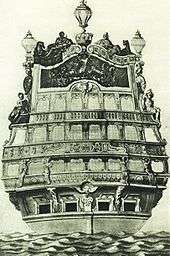
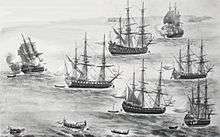
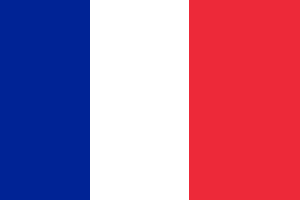

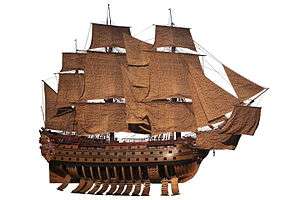
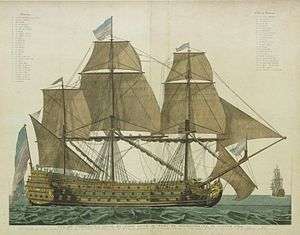

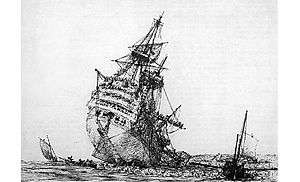
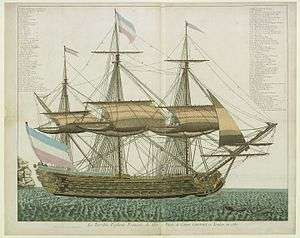






.jpg)
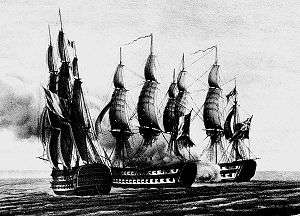


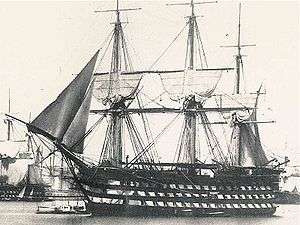



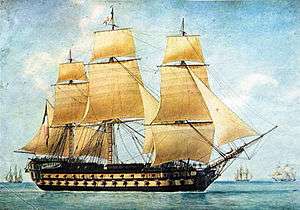

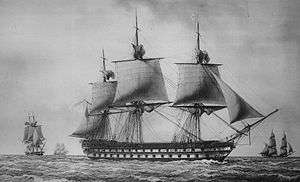

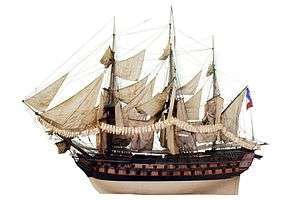
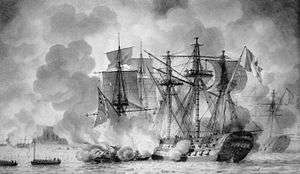

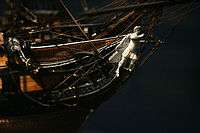


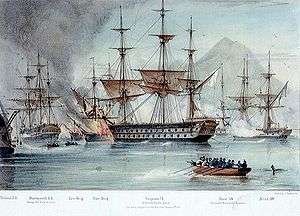
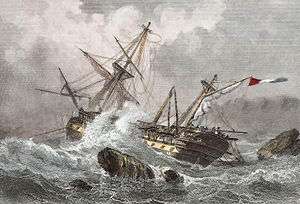
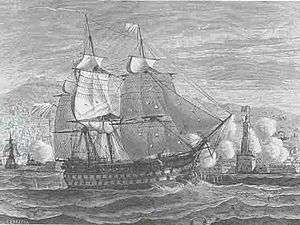




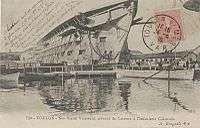
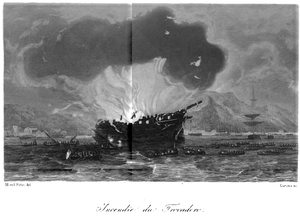
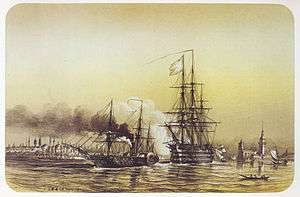


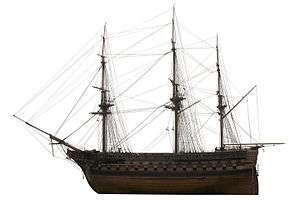
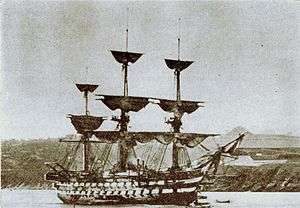



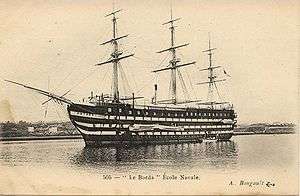

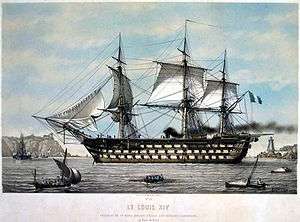



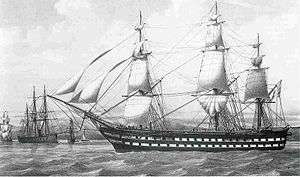
.jpg)
